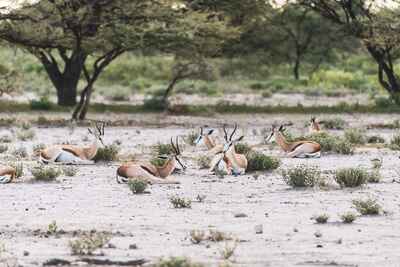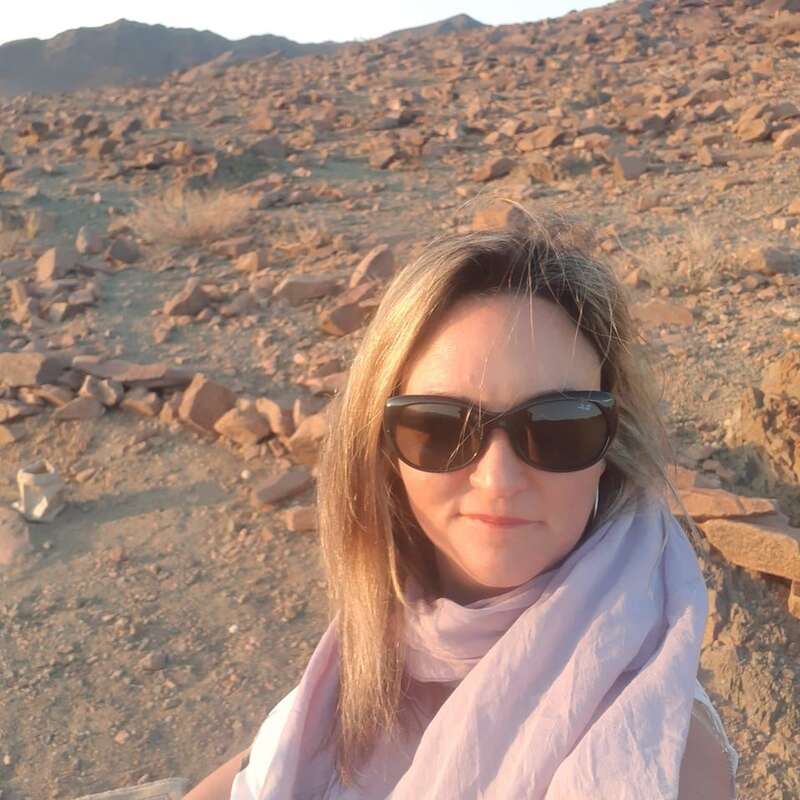About Namutoni Camp
Namutoni Camp stands on the eastern side of Etosha National Park, close to the von Lindequist Gate and the ...
... picturesque Fischer's Pan. Here, great concentrations of water birds and breeding colonies of flamingos can sometimes be seen during the rainy season. Namutoni itself also overlooks the small King Nehale waterhole, where game animals can be spotted occasionally.
Although still a bit rough around the edges, the recently refurbished rooms at Namutoni appeared smart and functional. You may not experience the same level of personal service or overall quality of experience here as at some of the smaller, private lodges in the area, but the camp provides a good base to explore the eastern side of Etosha National Park.
Our view
Although still a bit rough around the edges, the recently refurbished rooms at Namutoni appeared smart and functional. You may not experience the same level of personal service or overall quality of experience here as at some of the smaller, private lodges in the area, but the camp provides a good base to explore the eastern side of Etosha National Park.
Accommodation
44 rooms/chalets
Children
Best for aged 6+
Open
All year
Activities

4WD Safari

Birdwatching

Night drive

Private activities
Traveller reviews of Namutoni Camp
90 real, un-edited reviews from Expert Africa's travellers.
Arrived 9 Oct 2024, 2 nights
"Namutoni Camp review"
Overall rating: Excellent
Arrived 15 Sep 2023, 1 nights
"Namutoni Camp review"
Overall rating: Good
Arrived 15 Sep 2023, 1 nights
"Namutoni Camp review"
Overall rating: Good
Arrived 23 Aug 2023, 1 nights
"Namutoni Camp review"
Overall rating: Excellent
Arrived 13 Nov 2022, 1 nights
"Namutoni Camp review"
Overall rating: Good
Arrived 11 Oct 2022, 1 nights
"Namutoni Camp review"
Overall rating: Excellent
Arrived 25 Sep 2022, 3 nights
"Namutoni Camp review"
Overall rating: Average
Arrived 16 Mar 2022, 2 nights
"Namutoni Camp review"
Overall rating: Average
Arrived 28 Oct 2019, 1 nights
"Clean and comfortable"
Overall rating: Good
Arrived 24 Sep 2019, 2 nights
"Good"
Overall rating: Good
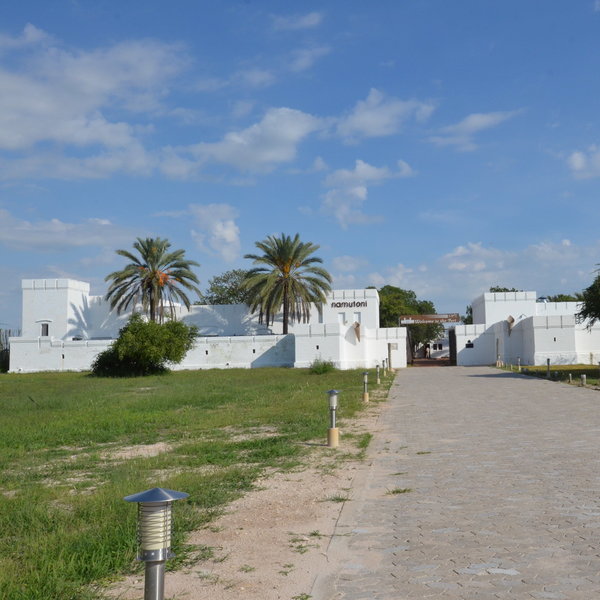
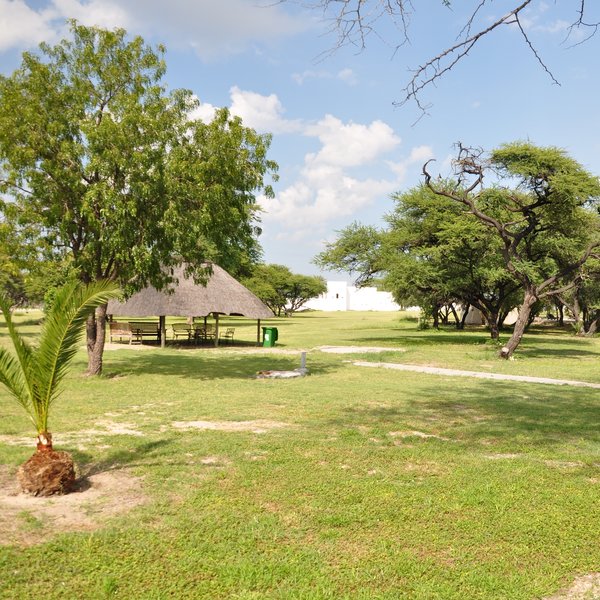
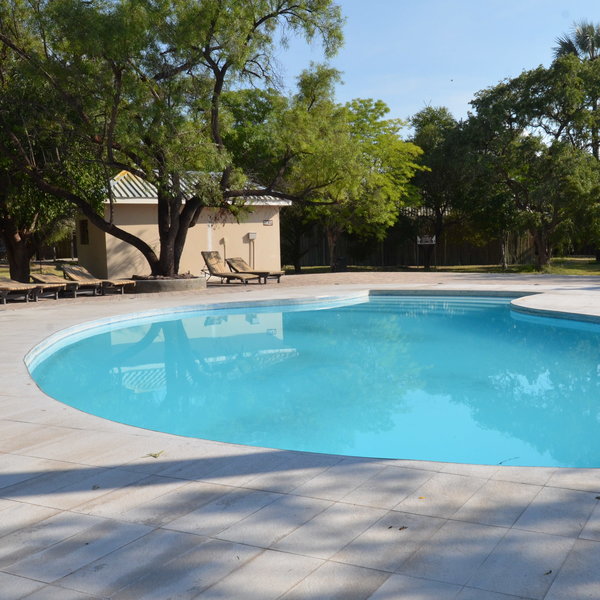
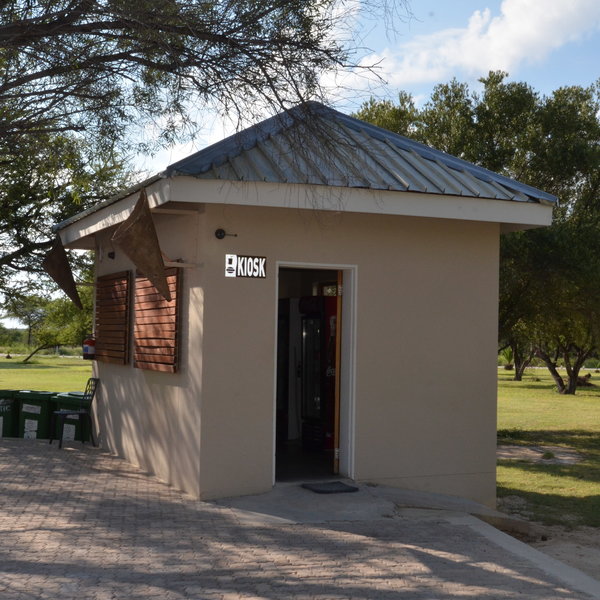
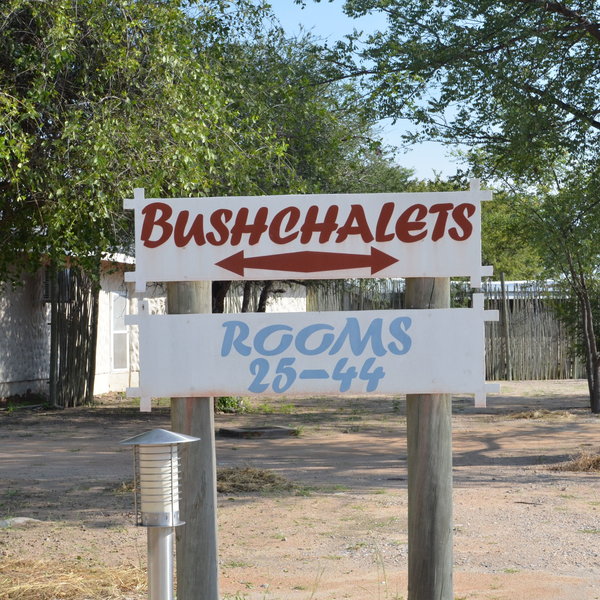
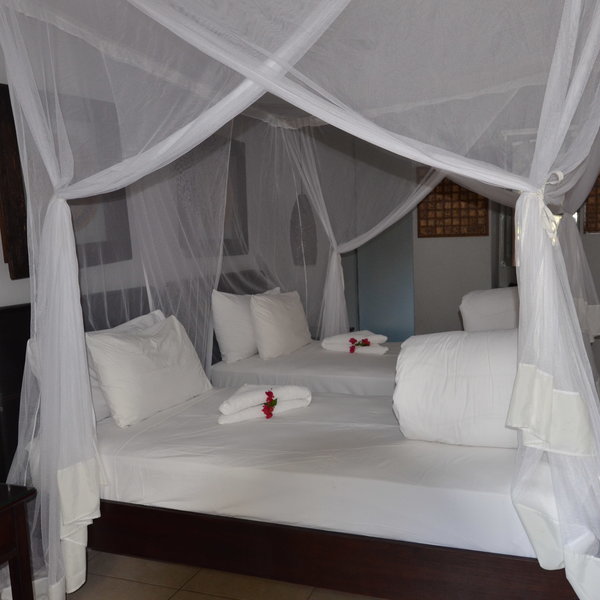
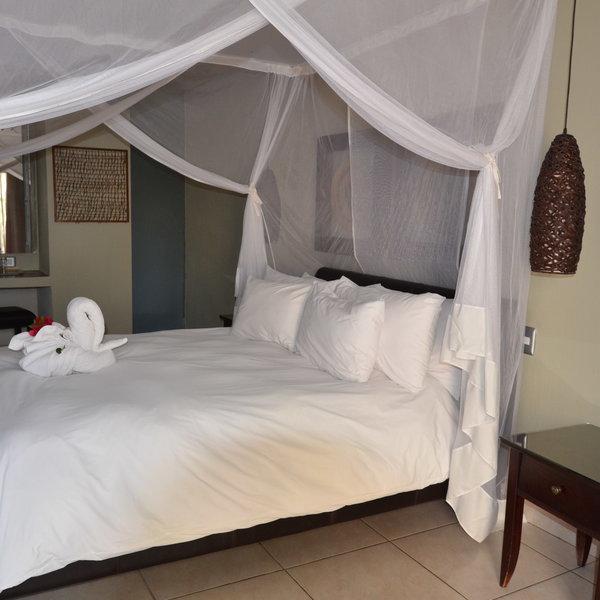
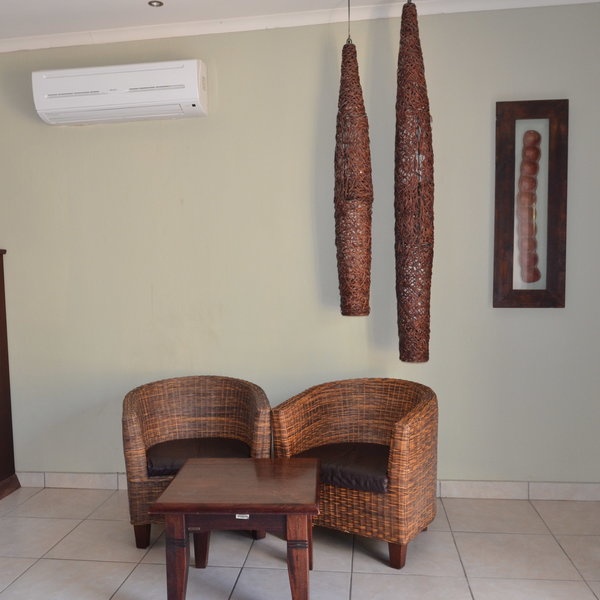
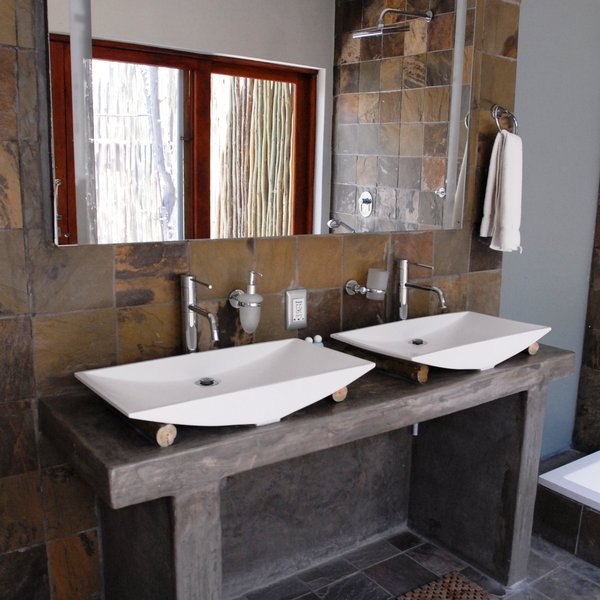
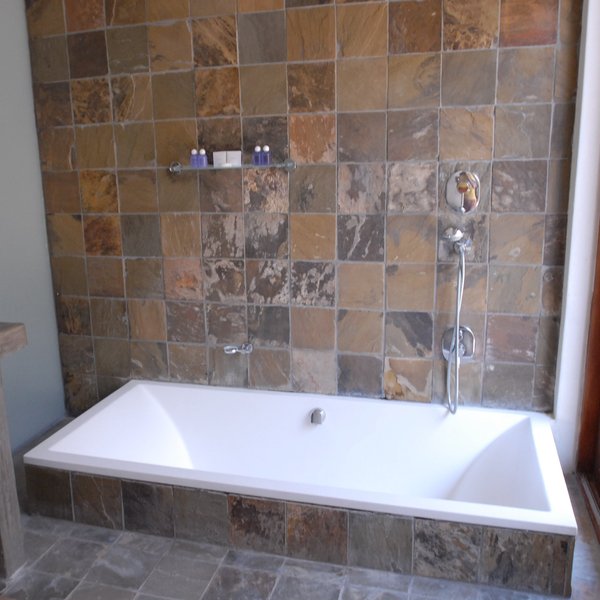
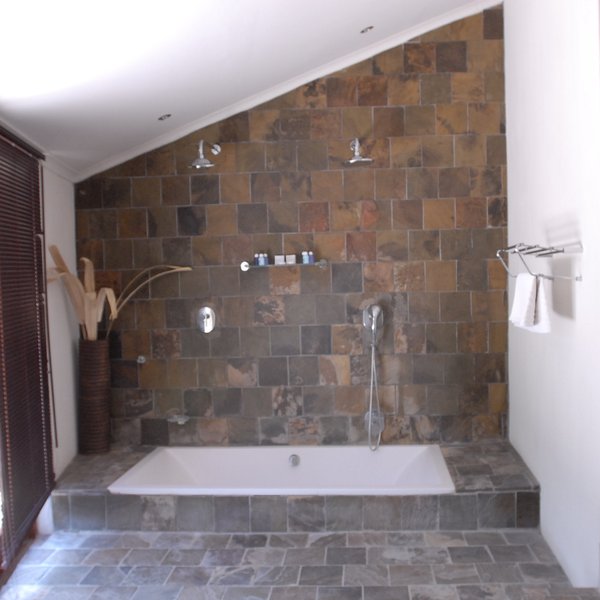
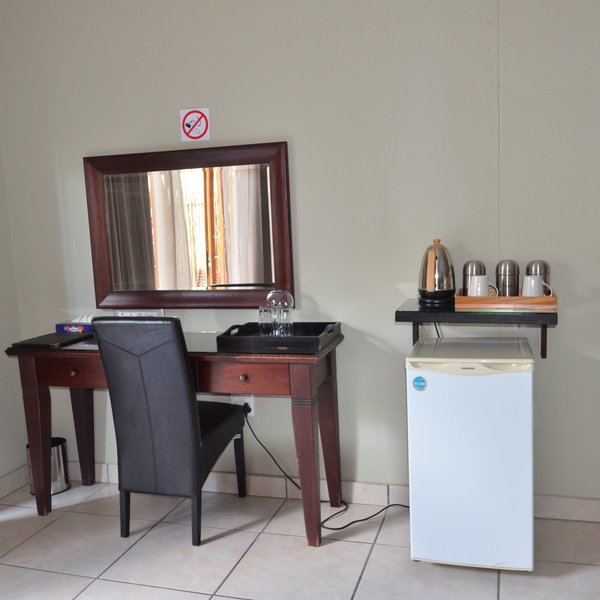
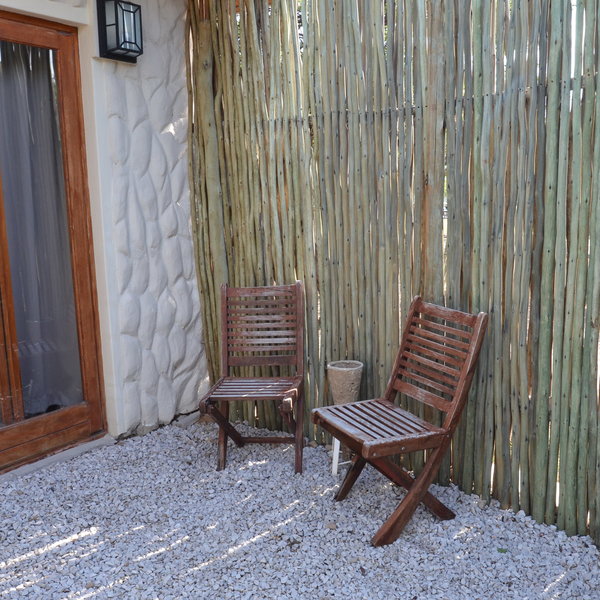
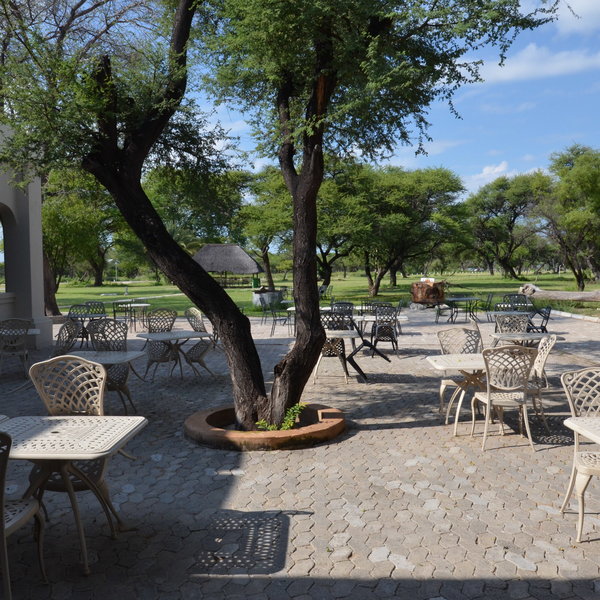
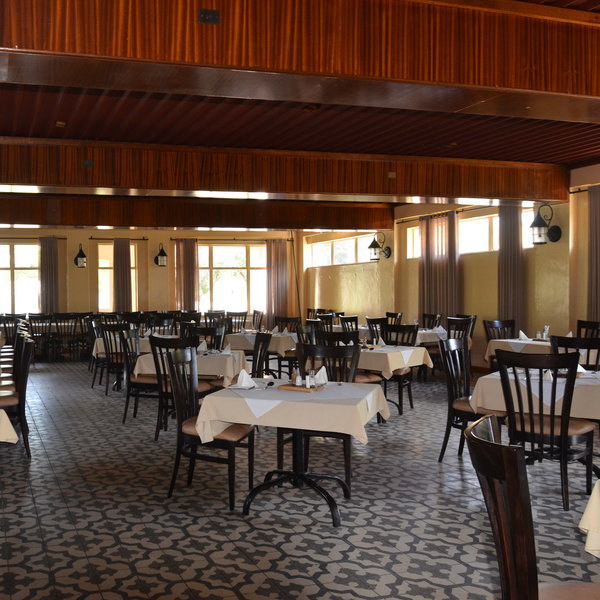
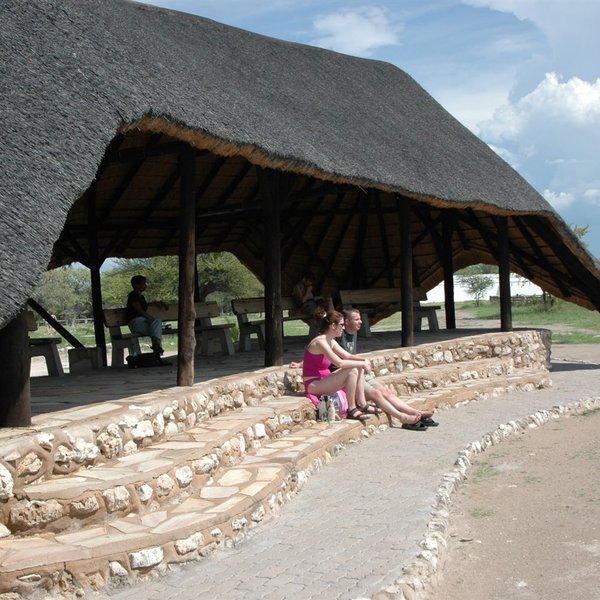
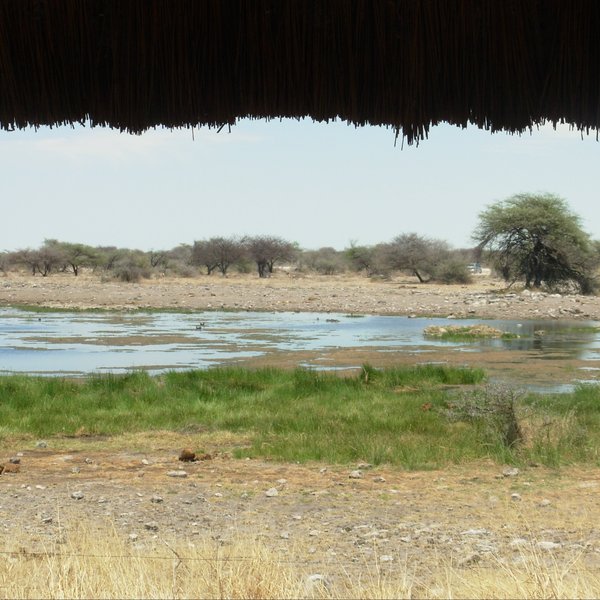
Expert Africa's gallery
When we travel we take lots of photos ourselves to give you a real and un-edited view of the safaris. See our 20 pictures of Namutoni Camp to get the candid view.
View galleryNamutoni Camp: Our full report
Namutoni Camp stands on the eastern side of Etosha National Park, close to the von Lindequist Gate and the ...
... picturesque Fischer's Pan. Here, great concentrations of water birds and breeding colonies of flamingos can sometimes be seen during the rainy season. Namutoni itself also overlooks the small King Nehale waterhole, where game animals can be spotted occasionally.
Namutoni is scattered around a white-washed old German fort, which gives the camp its unique character. Built in 1899, the fort was originally used as an outpost for German troops, and almost completely destroyed by 500 Owambo warriors in the battle of Namutoni, on 28 January 1904. It was rebuilt two years later, and after restoration works declared a National Monument in 1950.
Namutoni Restcamp (as it was originally known) officially opened for visitors in 1958, under the control of the Namibian government. In 1999, control of this and its sister restcamps in Etosha, Okaukuejo and Halali,,was passed to the para-statal organisation Namibia Wildlife Resorts (NWR), which refurbished the camp in 2007. This was a real step-change for the better in the camp's accommodation, and despite some reservations during a visit in 2014, we were pleasantly surprised by what we found on our most recent visit in March 2017.
The impressive and characterful fort at Namutoni is now barely used – apart from a small curio shop inside the courtyard – and it is no longer possible to walk up onto the ramparts. We can’t help but feel that this is a waste of such an iconic building, but the manager who walked us around Namutoni thought that the NWR were planning to build VIP rooms here – albeit probably a few years off.
Namutoni Camp boasts a total of 20 chalets and 24 rooms. All have en-suite bathrooms and outdoor showers, and are equipped with fridges and tea stations. Despite the lacklustre appearance of the main areas of the camp, all the accommodation was renovated in 2016 and looked smart when we visited. There are also camping pitches with plug points and communal ablution facilities.
- The 20 bush chalets – six doubles and 14 twins – are situated back to back in blocks of two, so that the front doors face in opposite directions. Inside, the rooms are elegant and spacious and they looked very clean. Neutral cream and dark brown tones dominate throughout and black-and-white wildlife photos hang on the walls. Framed seedpods and large cylindrical light shades made of natural materials add a stylish touch, while a writing desk and chair, and small wicker chairs and a table, complete the furniture.
Down a step is the en-suite bathroom, which has stone-effect tiles on the floor and walls. There are rectangular his and hers sinks, and a sunken bath that requires another step down in order to get in. There is also an inviting outdoor shower. At the front of the chalet is a private outdoor area, its gravel floor surrounded by wooden screens and set with two chairs. - The 24 double rooms are connected along concrete pathways (thankfully, NWR has removed the raised wooden walkways which we previously had concerns about). The rooms are in blocks of four and each has a small private seating area at the front.. They are slightly smaller than the bush chalets both inside and out, but otherwise are very similar.
For guests at Namutoni Camp, activities revolve around nature and wildlife. The King Nehale waterhole is floodlit at night and viewing benches provide opportunities to encounter some of Etosha’s shy, nocturnal game.
Most guests here drive themselves around the park during daylight hours, but the park authorities also run guided game drives, including night drives – which are not permitted by self-drivers. Drives set off at 5.30am, 3.00pm and 8.00pm, returning to camp about three hours later.
Activities
4WD Safari
Birdwatching
Night drive
Private activities
Families & children
- Attitude towards children
- Children are welcome at Namutoni Camp.
- Property’s age restrictions
- There are no age restrictions at Namutoni Camp.
- Special activities & services
- Children must be over six to participate in game drives with the camp.
- Generally recommended for children
- The flexibility of a self-drive trip often suits families very well, though as there is not a lot to keep children occupied at the camp, we do not think that it would suit very young children.
- Notes
- Note that dangerous animals do sometimes enter the camp area, and the pool is unfenced, so care needs to be taken and parents must always supervise their children closely.
Food & drink
- Usual board basis
- Bed & Breakfast
- Food quality
- Although we did not eat at Namutoni on our most recent visit in March 2017, we did glance at the restaurant menu .
There is a breakfast buffet serving both hot and cold items.
Lunch is an à la carte menu with options of soup, game salad, lamb chops and toasted sandwiches, with fruit salad or ice cream for dessert.
Depending on how many people are staying at the camp, dinner will be either a buffet or à la carte. Options include salmon, game steak, kingklip, pork chop and a vegetable dish, followed by cake or mousse for dessert. - Dining style
- Individual Tables
- Dining locations
- Indoor and Outdoor Dining
- Further dining info, including room service
- No
- Drinks included
- No drinks are included. The water can not be drunk as it is too salty but bottled water is available to buy.
Our travellers’ wildlife sightings from Namutoni Camp
Since mid-2018, many of our travellers who stayed at Namutoni Camp have kindly recorded their wildlife sightings and shared them with us. The results are below. Click an animal to see more, and here to see more on our methodology.

100% success

100% success

100% success

100% success

94% success

73% success

64% success

62% success

55% success

50% success

31% success

15% success

14% success

0% success

0% success

0% success

0% success
Getting there
- Location
- Etosha National Park, Namibia
- Ideal length of stay
- 2–3 nights, often combined with visits to its sister camps, Okaukuejo and Halali
- Directions
- Namutoni is the most easterly of the NWR’s three erstwhile restcamps in Etosha. It is usually accessed via the von Lindequist Gate, from where it’s about a 12km drive.
- Accessible by
- Self-drive
Special interests
- Wildlife safaris
- Overlooks the flood-lit King Nehale waterhole, Namutoni gives visitors the opportunity to observe animals and birds at close range. The camp's main attracting are self-drive forays around the park. The Fisher's Pan nearby is often used as the breeding site for flamingoes.
- See ideas for Wildlife safaris in Namibia
Communications
- Power supply notes
- There is a back-up generator, although during our visit in March 2017, which was in the rainy season, this was not kicking in when the mains electricity went off.
- Communications
- There are no telephones but there is internet access around the pool and restaurant area. Vouchers for this WiFi must be purchased from the reception or the restaurant.
- TV & radio
- There are no radios or TVs.
- Water supply
- Mains
Health & safety
- Malarial protection recommended
- Yes
- Medical care
- There is a first-aid kit at Namutoni and some of the staff are first-aid trained. The nearest doctor is in Tsumeb, about 115km away.
- Dangerous animals
- Moderate Risk
- Security measures
- There's a low stone wall between the waterhole and the chalets, to reduce the chances of dangerous animals entering the camp and security guards are also present at the camp.
- Fire safety
- All rooms have fire extinguishers.
Useful info
- Disabled access
- Not Possible
- Laundry facilities
- A laundry service is available for an extra charge.
- Money
- No currency exchange is available.
- Accepted payment on location
- Visa cards are accepted, but we would recommend using cash (in Namibian dollars or South African rand) because the process of using a credit card can be rather slow.
Plan and book your trip with Expert Africa
All of our trips are tailor-made, so we'll always adapt them to suit you. Talk to an Expert and let us plan and arrange your perfect trip.

Talk to an Expert
Call or email us now! We’ll match you with the Specialist in our team who is best suited to help you. Then together we can start planning your trip.

Set up your itinerary
Based on our experience and your ideas, your specialist will create a detailed, costed itinerary. We’ll refine it together, until we have a trip that you’re perfectly happy with.

Prepare for your trip
The same Specialist will make the seamless arrangements for your trip, send you detailed travel documents, and be available to answer any questions before you depart.

Travel with peace of mind
After you set off, you’ll be cared for by our partners in Africa, most of whom have worked with Expert Africa for decades. And if you ever need us urgently, we’re available 24/7.

When you return
We love to learn about your trip, and so will always be grateful if you’ve the time to give feedback to your Specialist when you return.
Namutoni Camp's location
Look closer at the environment and surroundings of Namutoni Camp.
Other lodges in Etosha National Park
Alternative places to stay in this same area.
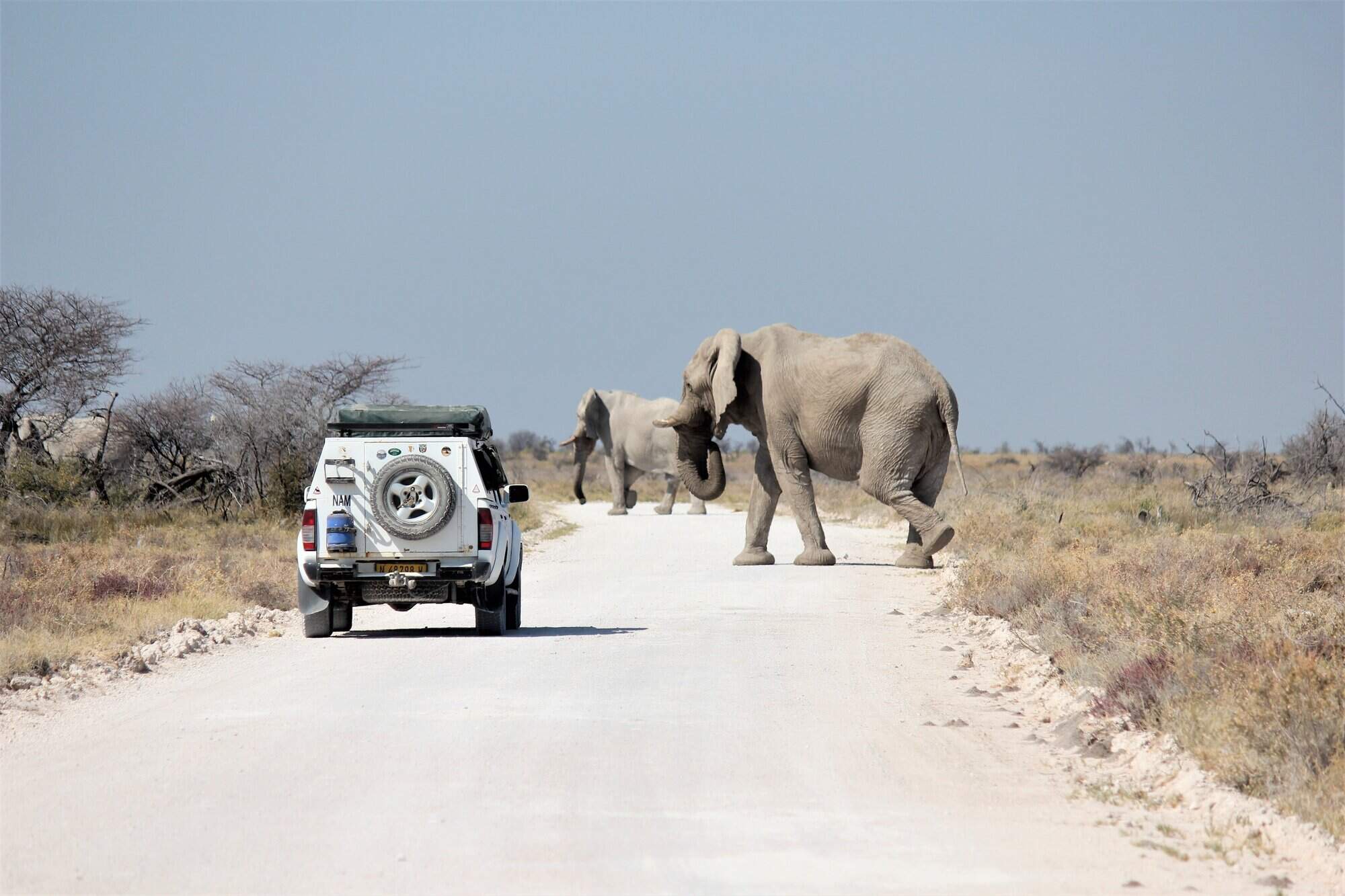
Okaukuejo Camp
Set within Etosha National Park, Okaukuejo Resort is a large camp with a productive, floodlit waterhole.
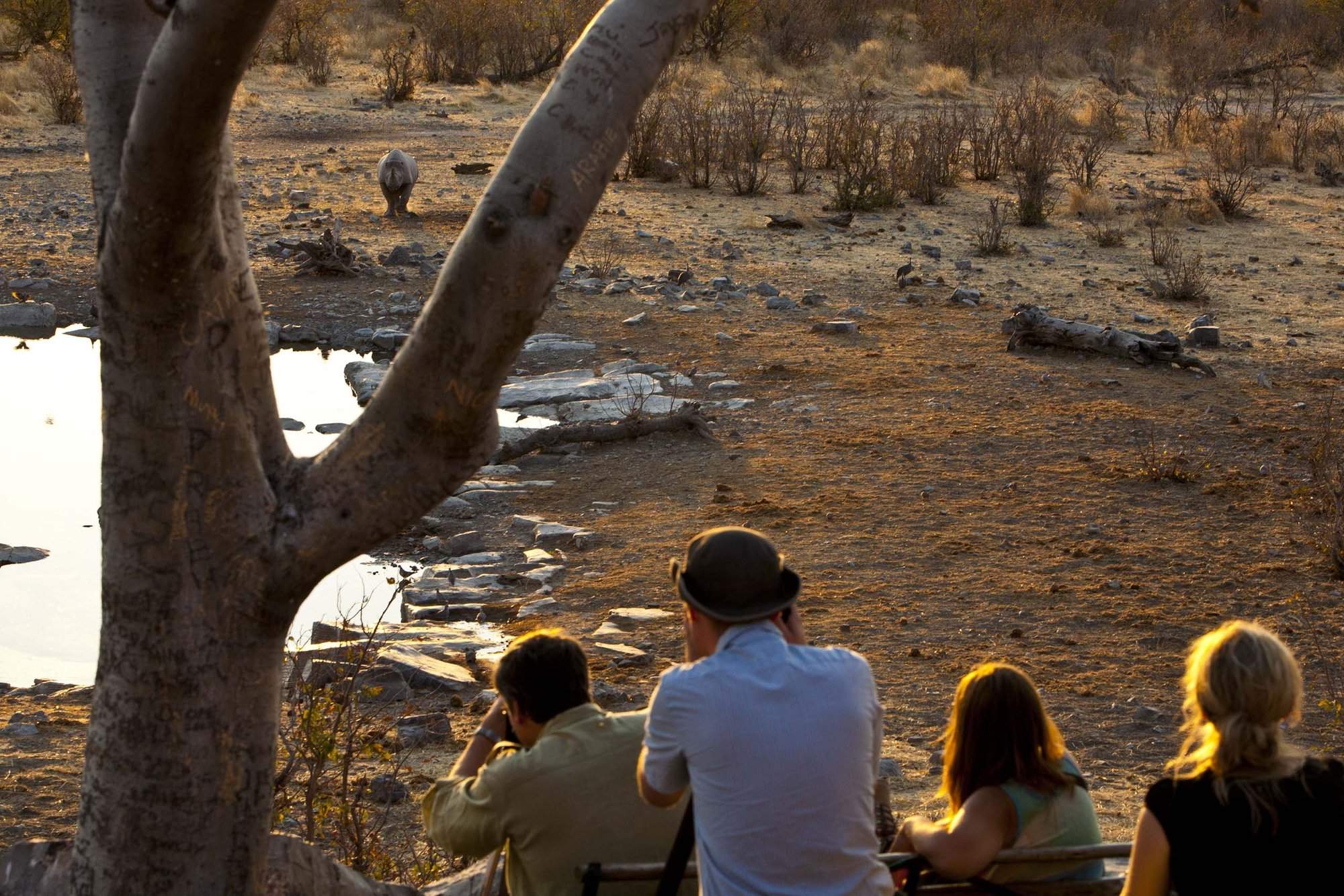
Halali Camp
The smallest of Etosha's erstwhile restcamps, overlooking its own floodlit waterhole, Halali has a superb location near the centre of Etosha Pan.
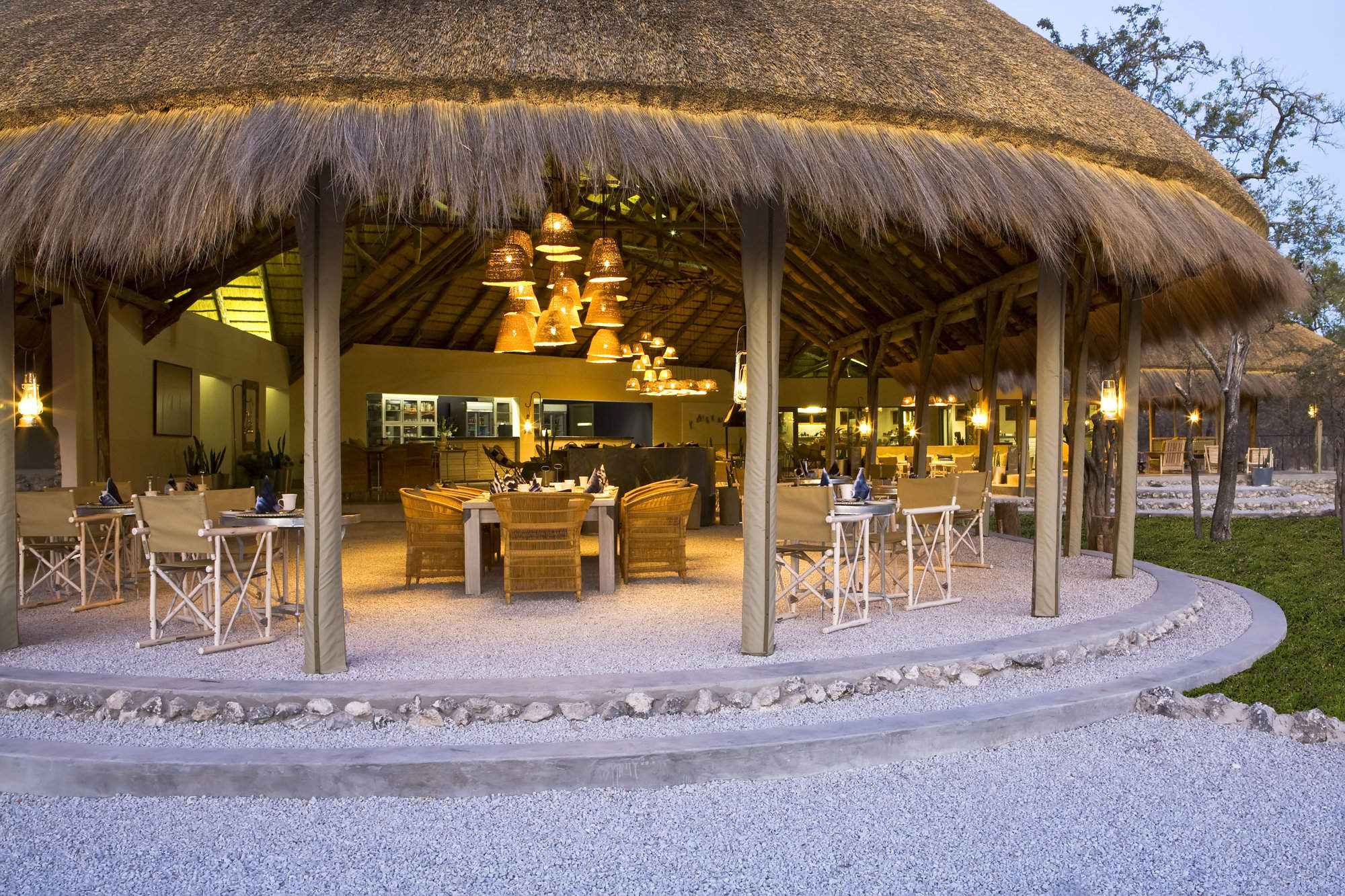
Mushara Bush Camp
The family-friendly Mushara Bush Camp offers great value and is an excellent base from which to explore Etosha National Park.
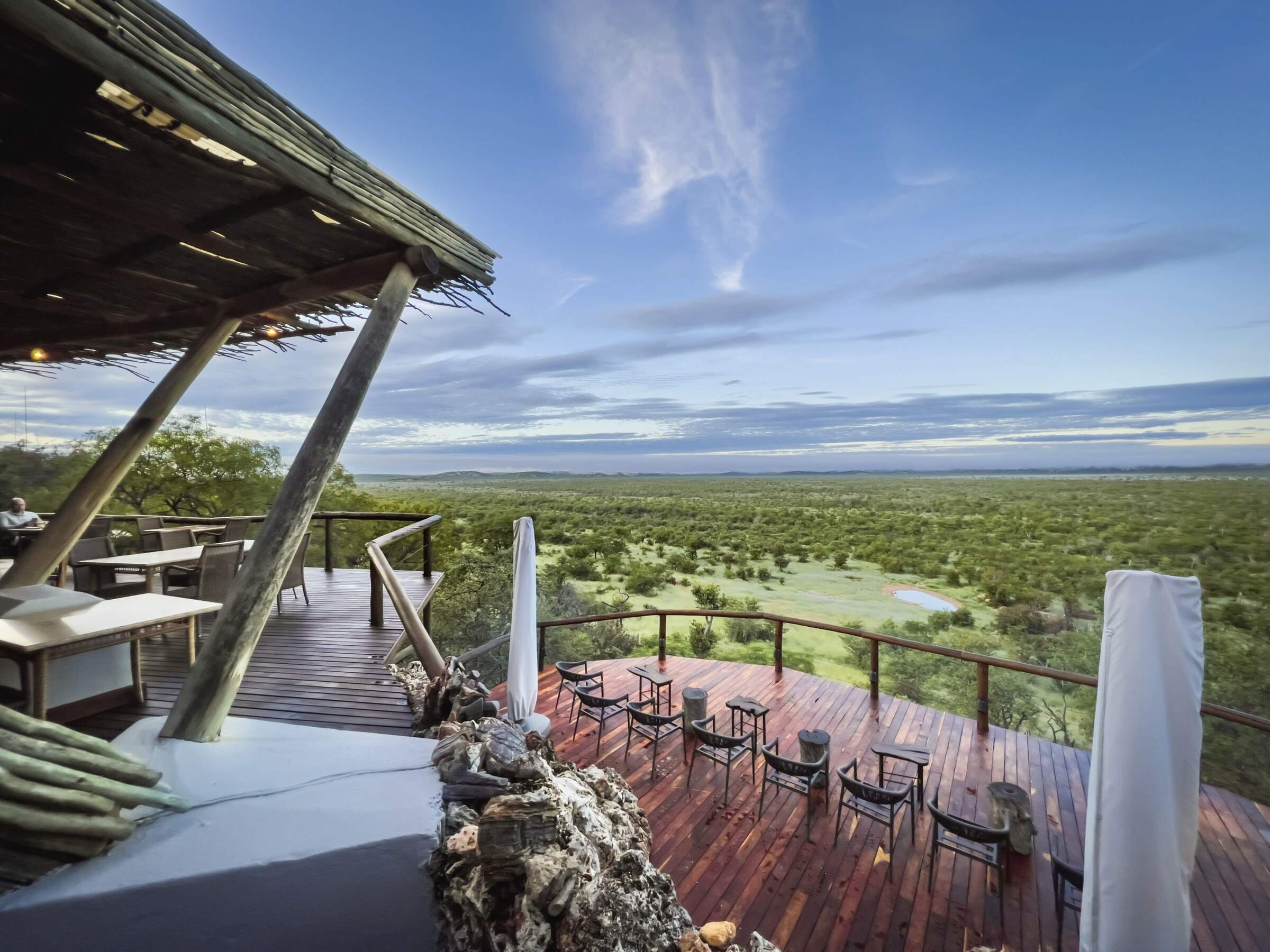
Ongava Lodge
With fantastic views over a private reserve bordering Etosha, the smart Ongava Lodge offers driving and walking safaris on the reserve, and guided drives in Etosha.
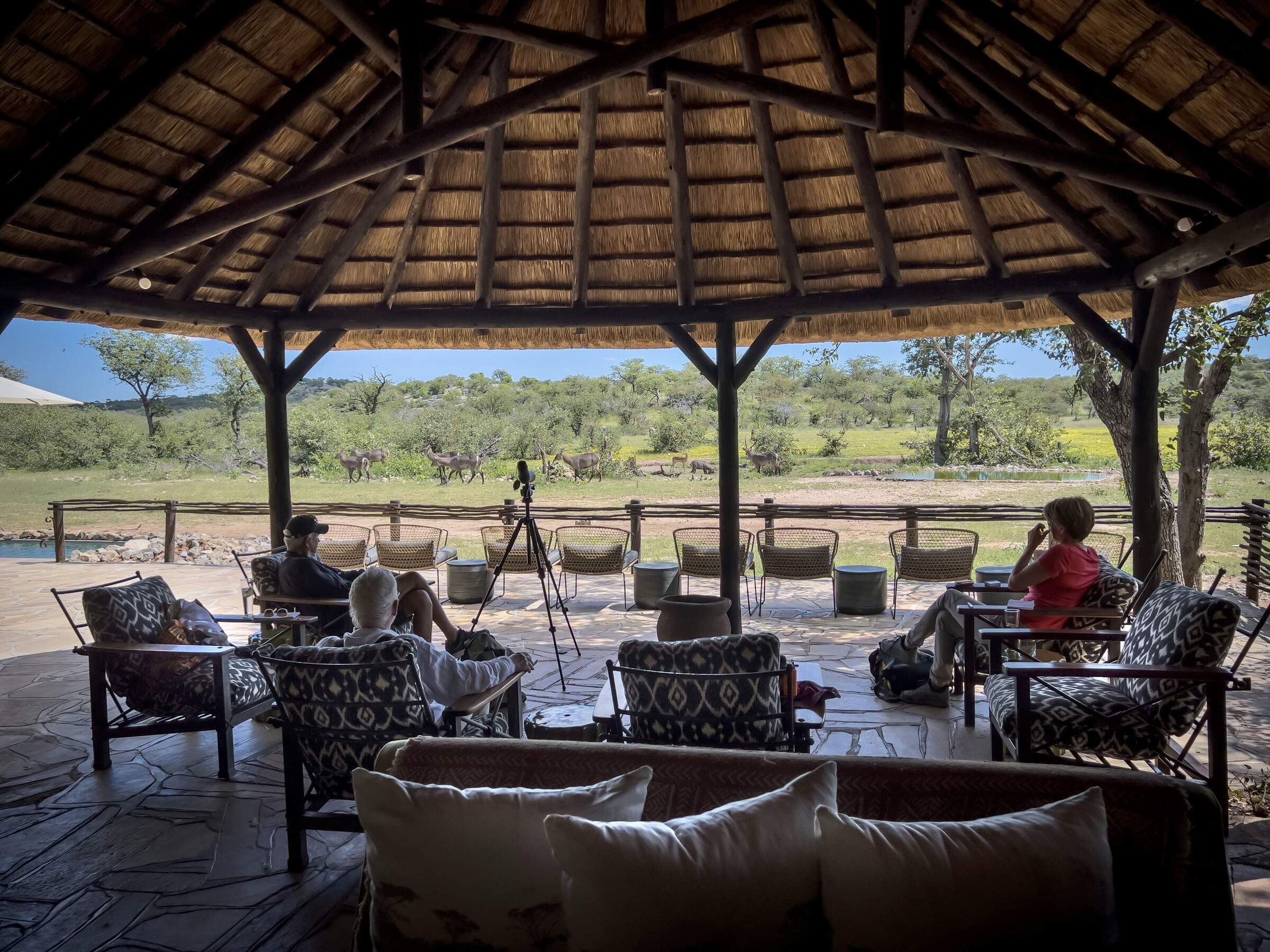
Ongava Tented Camp
Set around a waterhole on a private reserve, the small Ongava Tented Camp combines understated comfort with activities that include walks and night drives.
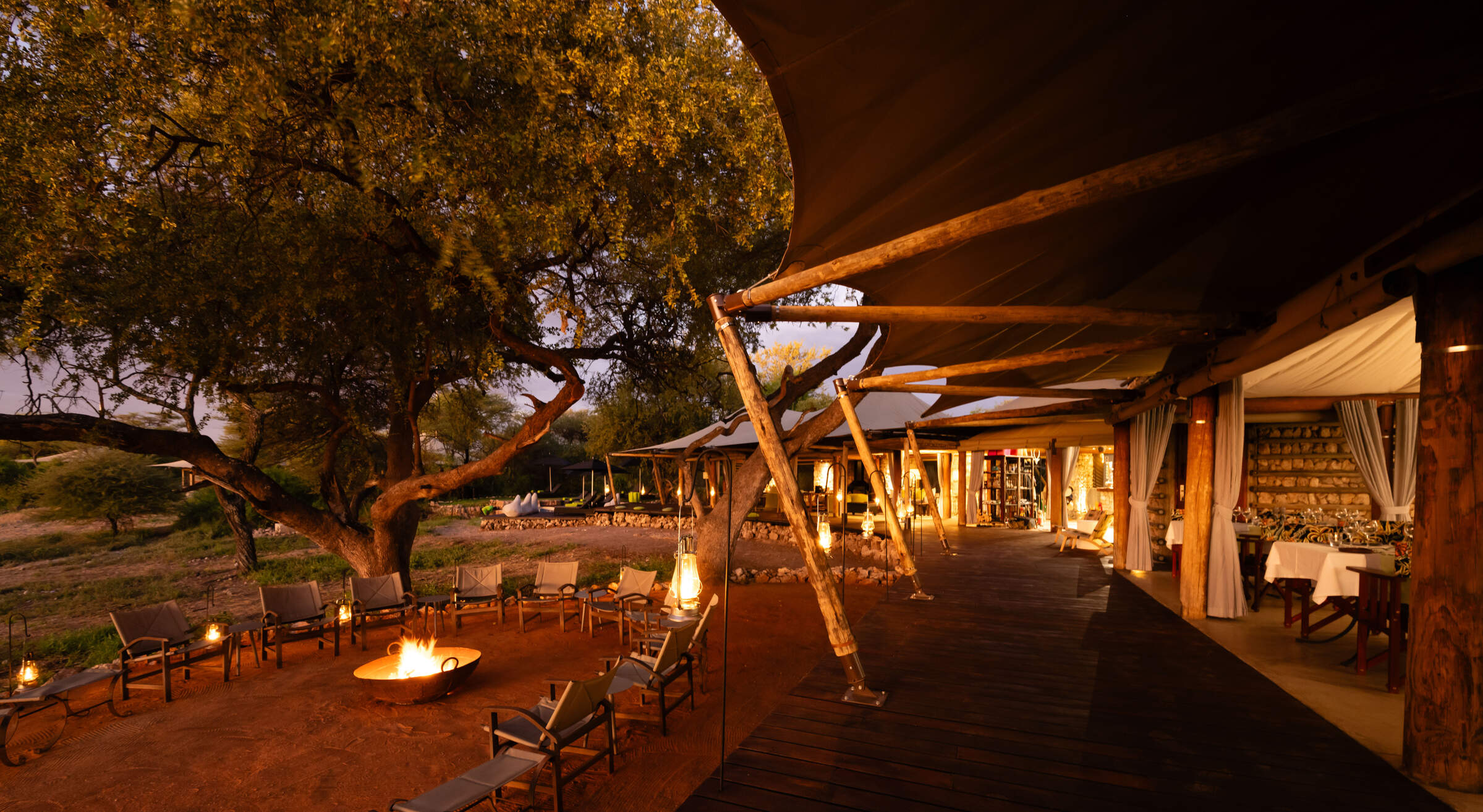
Onguma Tented Camp
Onguma Tented Camp is a lovely, little tented camp which centres around an attractive waterhole a short drive from the Von Lindequist Gate to eastern Etosha.
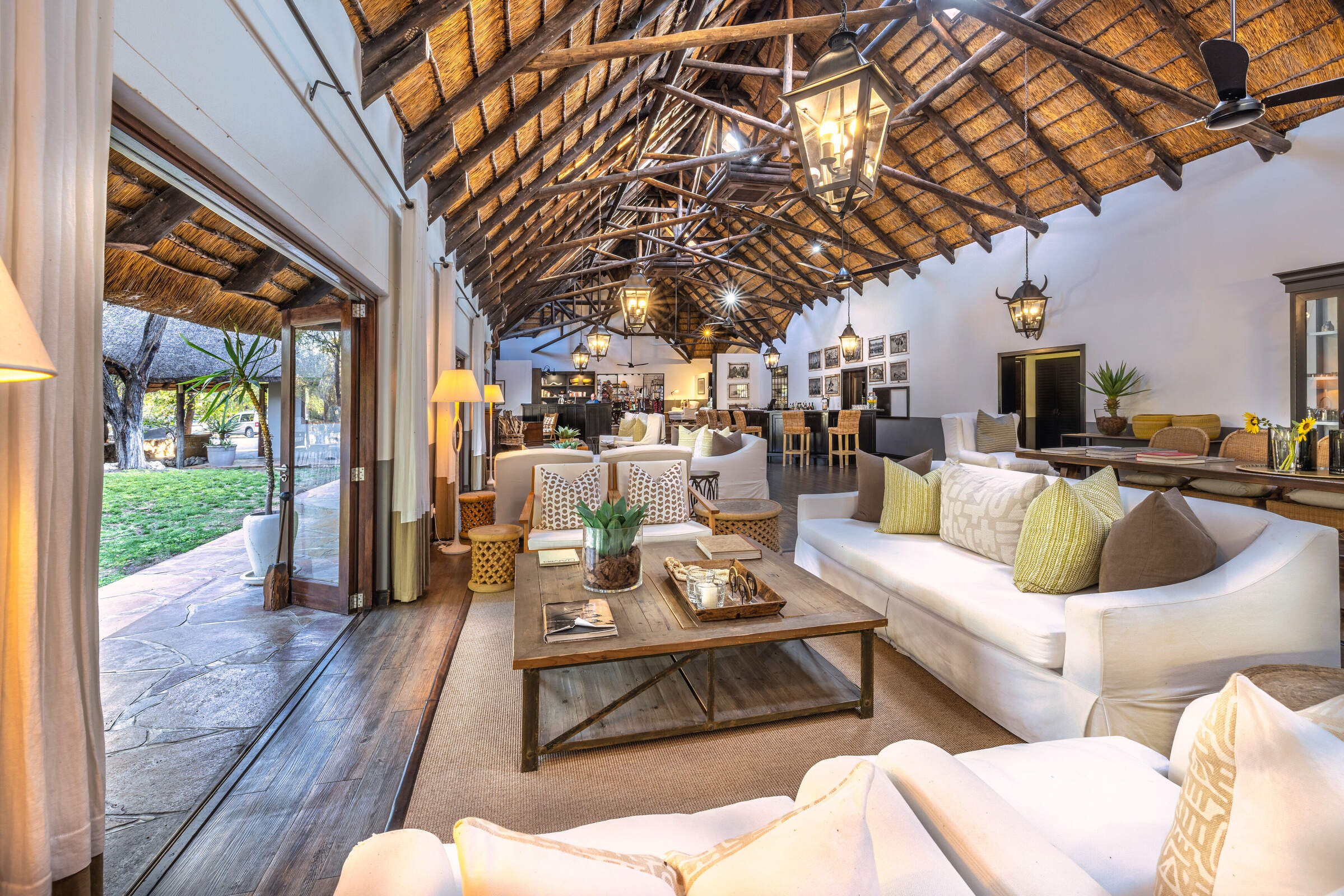
Mushara Lodge
Close to the eastern entrance to Etosha, the comfortable Mushara Lodge is well-placed for exploring the park in your own vehicle or on a guided drive.
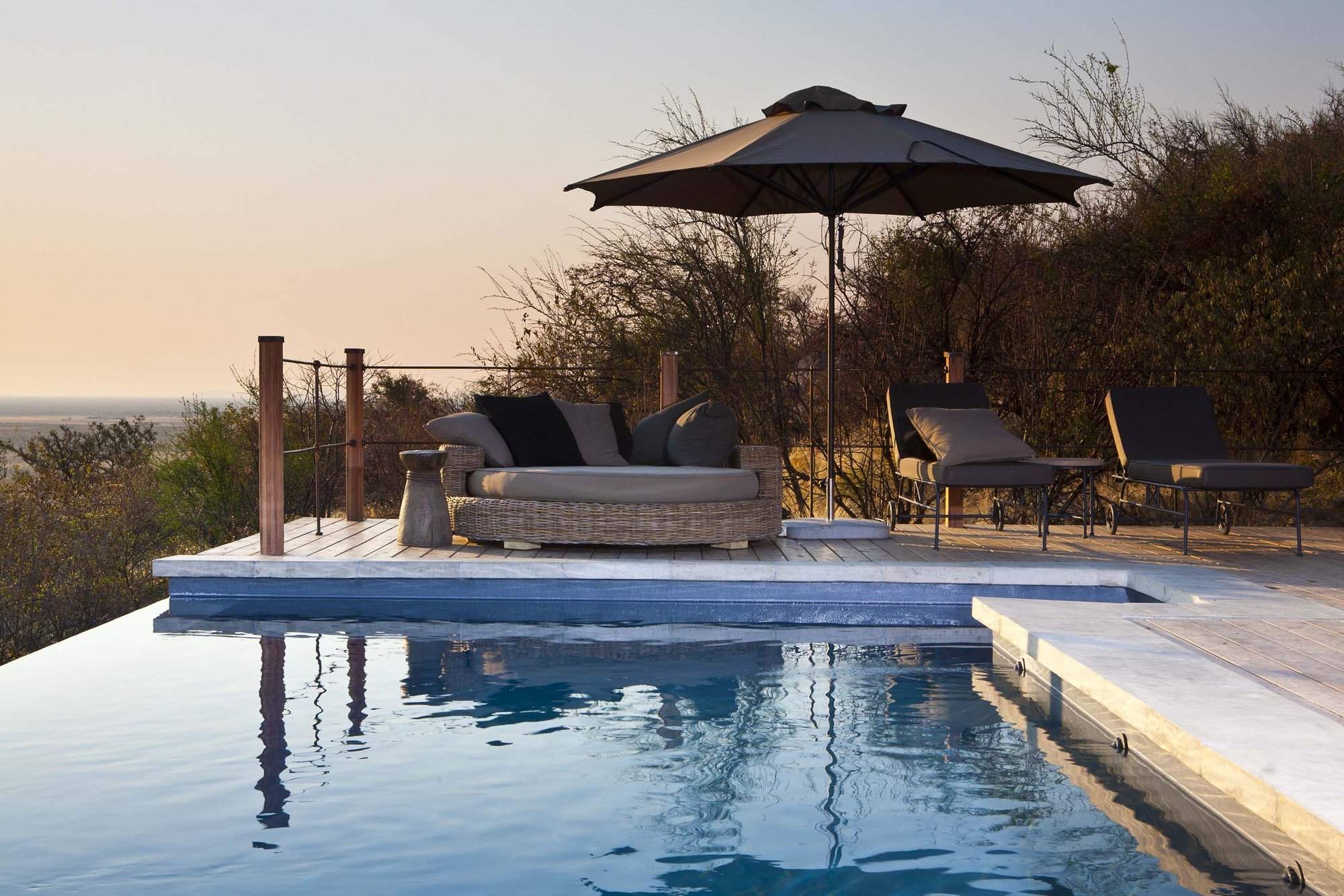
Dolomite Camp
Opened in 2011, Dolomite Camp allows visitors access to the far west side of Etosha National Park, which was previously off limits to most visitors.

Onguma Bush Camp
For great wildlife viewing without breaking the bank, the affordable and understated luxury of Onguma Bush Camp could be perfect.
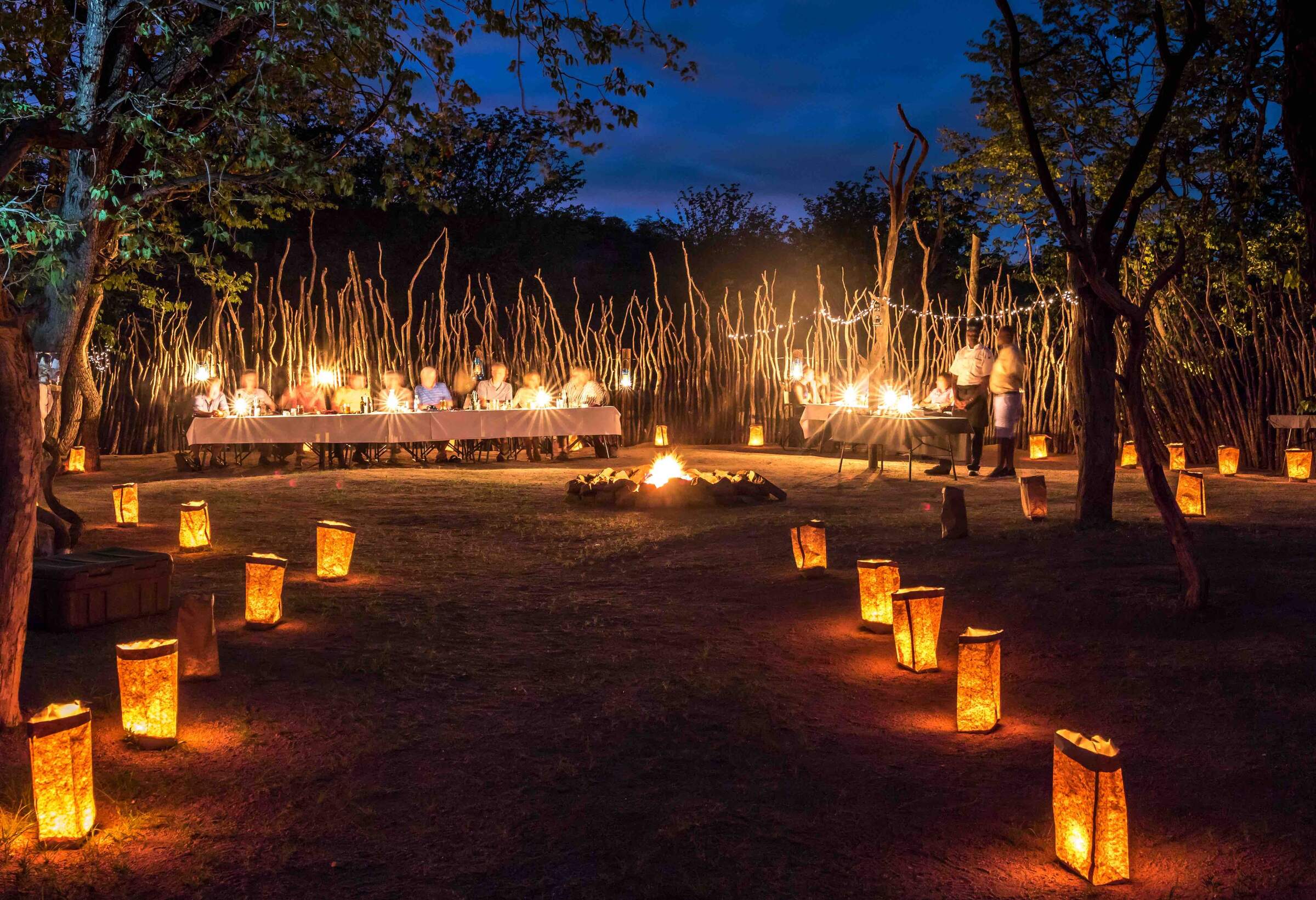
Hobatere Lodge
To the west of Etosha National Park, on the edge of Damaraland, Hobatere Lodge offers good game-viewing on its own reserve.
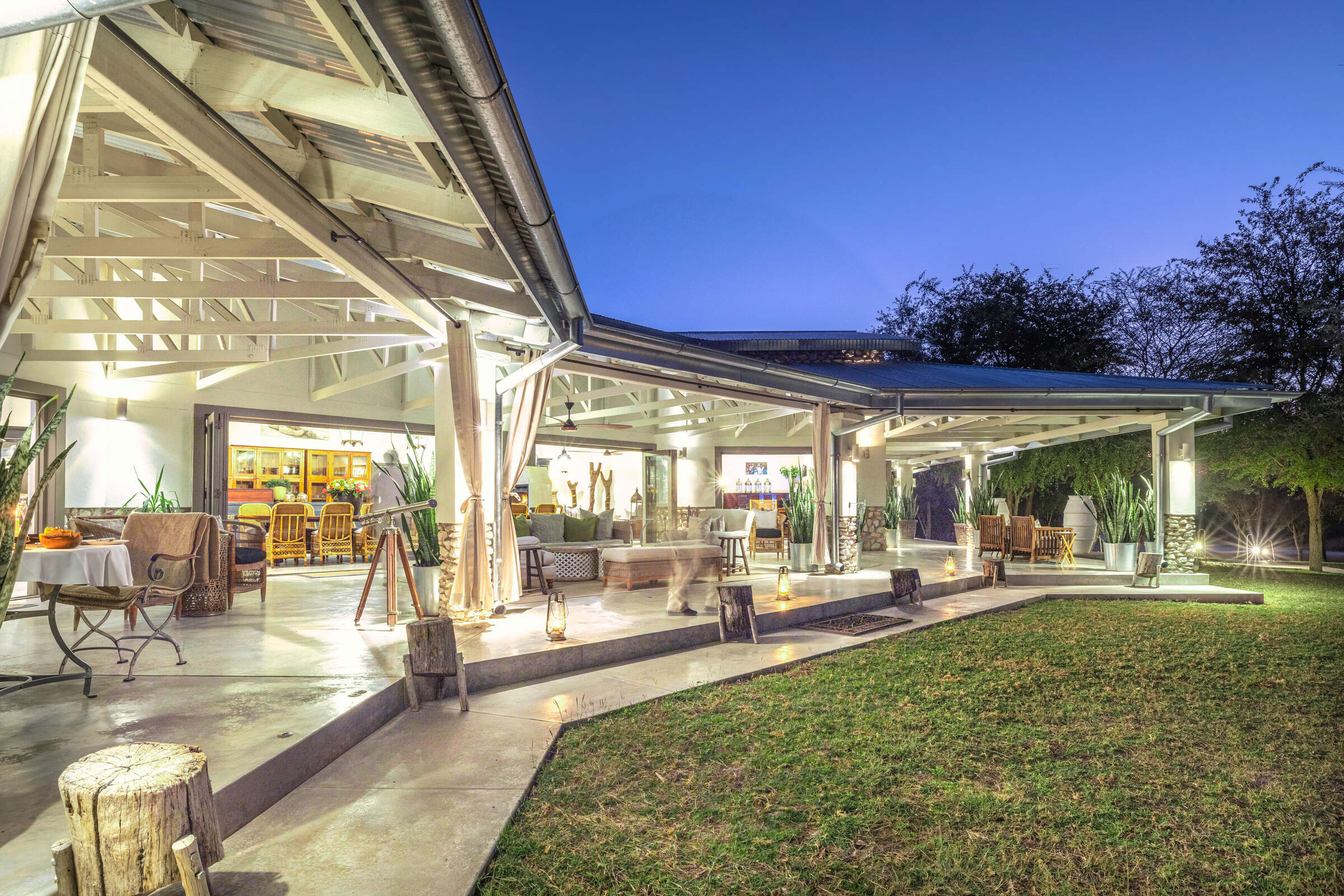
Mushara Outpost
Intimate and luxurious, Mushara Outpost is well-placed on a private reserve to explore nearby Etosha National Park on your own or on a guided drive.
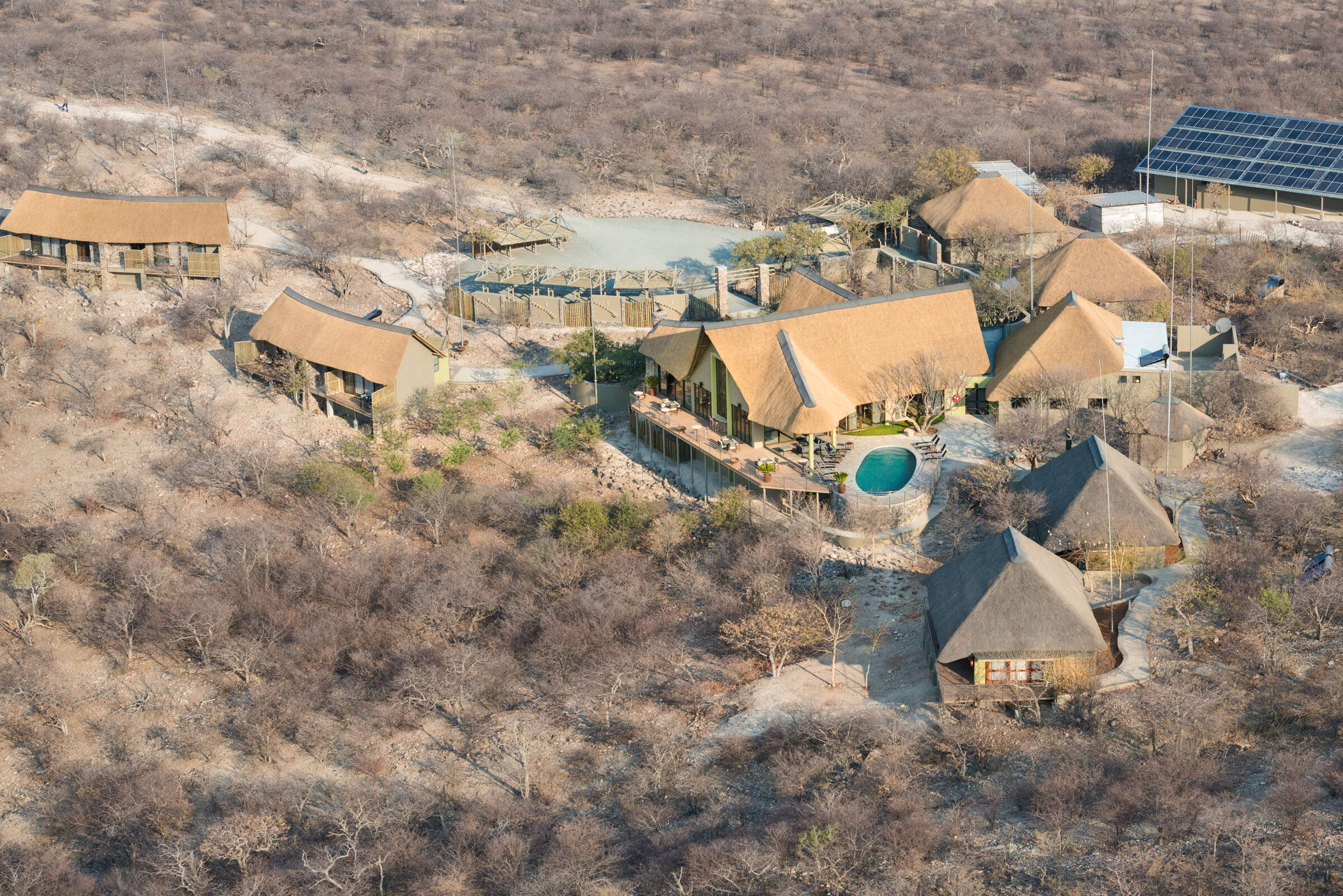
Safarihoek Lodge
At the heart of the private Etosha Heights Reserve, Safarihoek Lodge offers comfortable accommodation and excellent game-viewing.
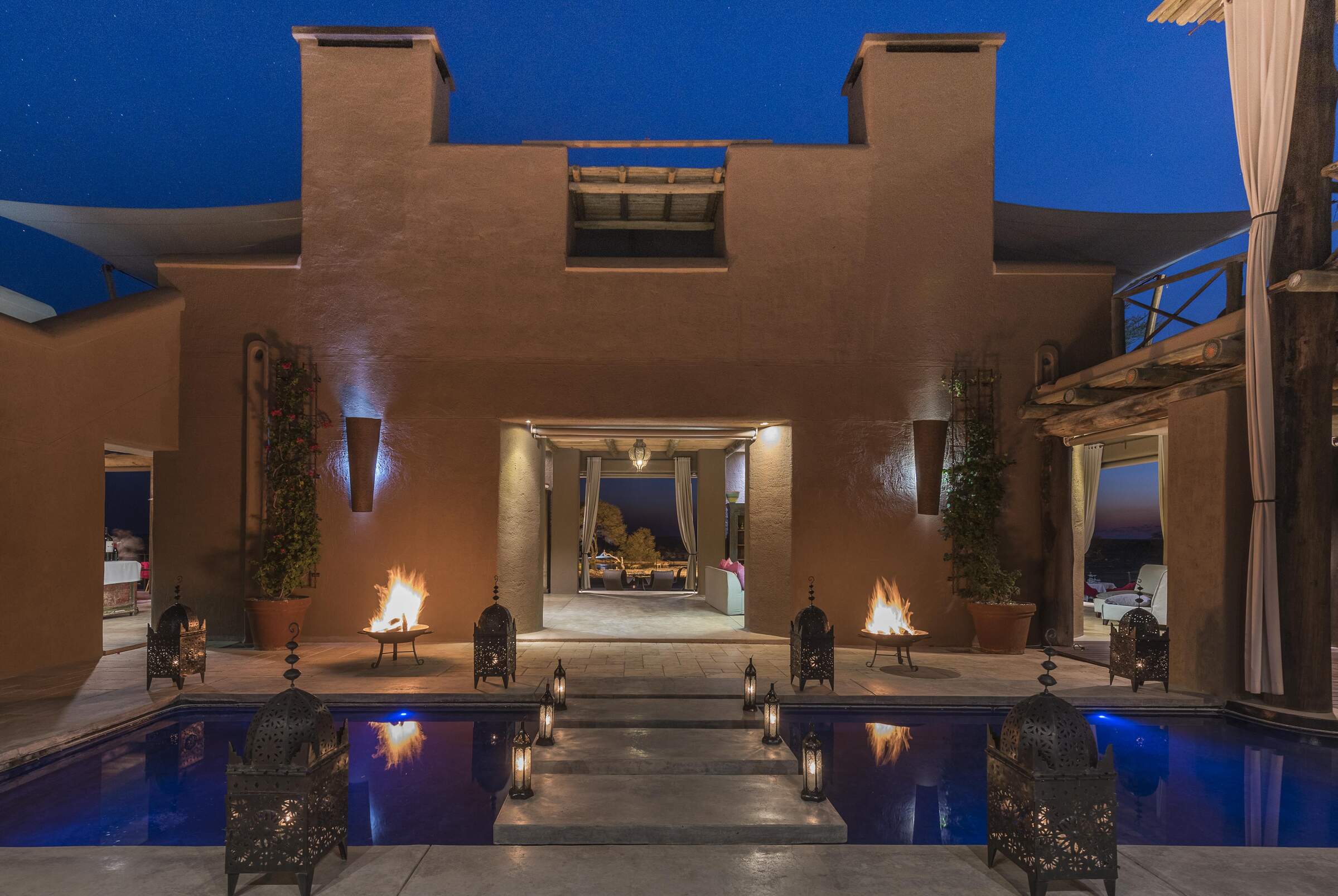
Onguma The Fort
The Fort is the jewel in the crown of the Onguma lodges, and arguably the whole of eastern Etosha.
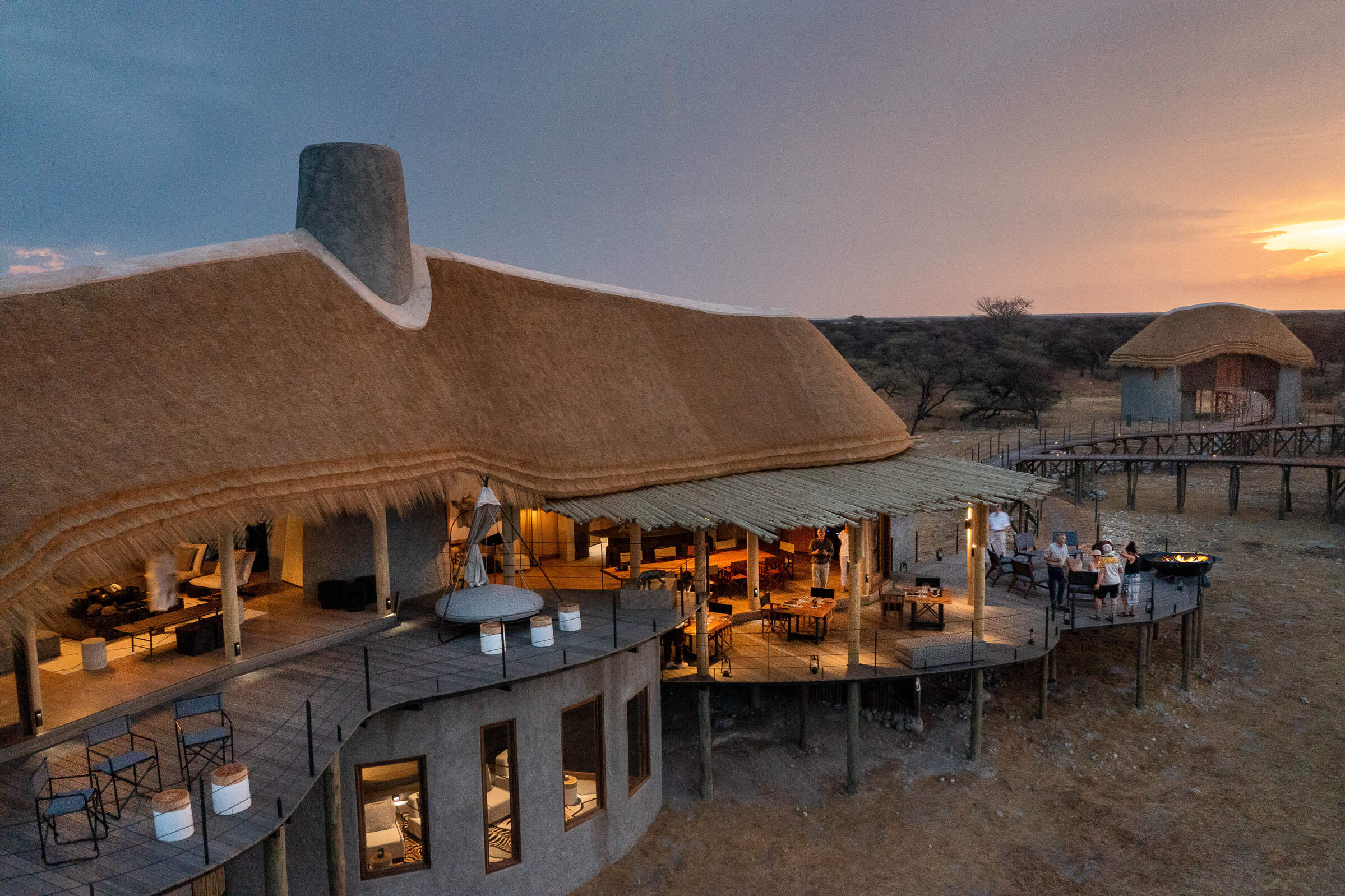
Onguma Camp Kala
For a bird’s eye view across African bush, the stilted rooms at Onguma Camp Kala are truly special.
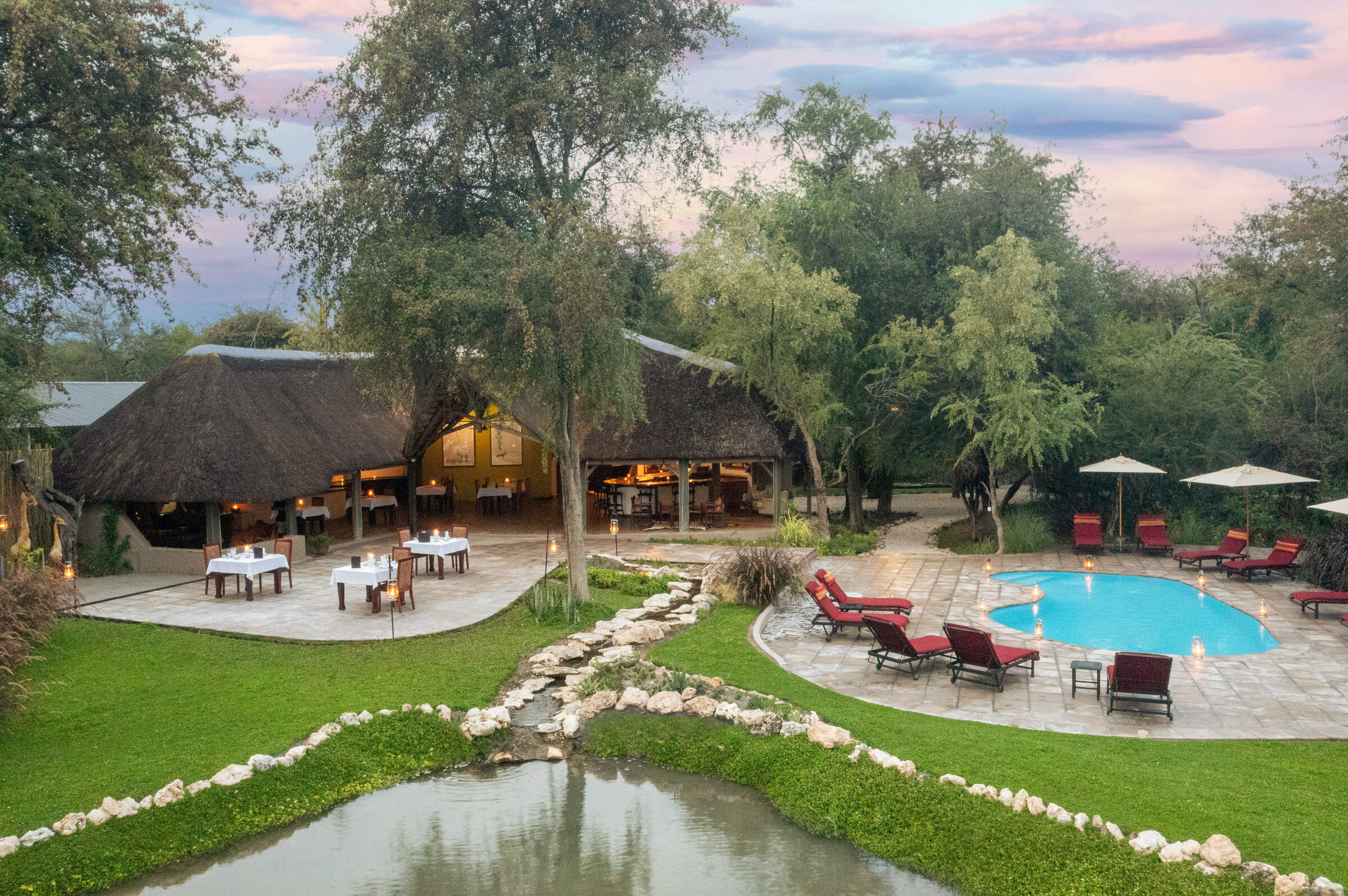
Onguma Forest Camp
From its woodland setting on the Onguma Reserve, Forest Camp is within easy striking distance of Namibia’s flagship national park.
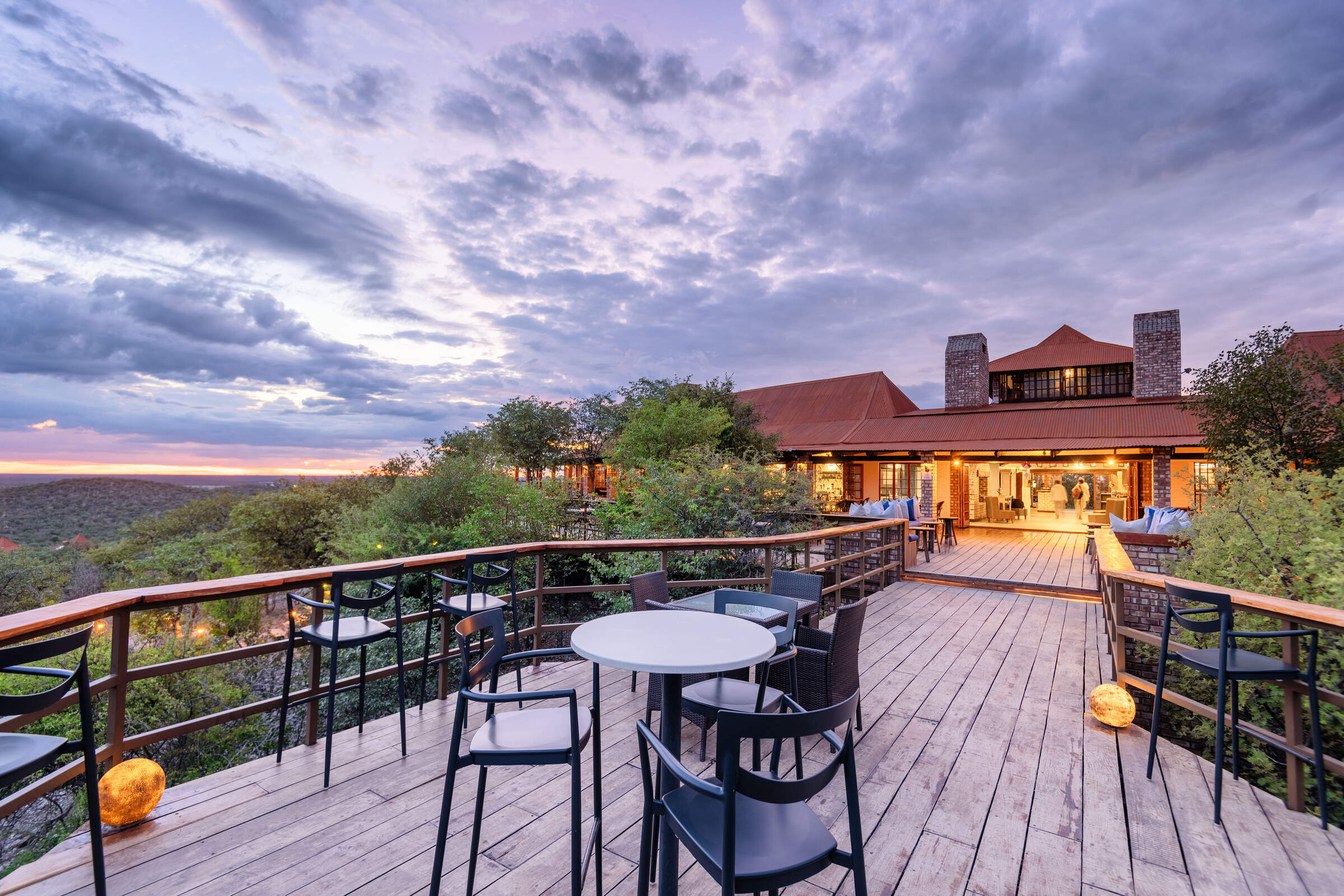
Etosha Safari Lodge
A short drive from Etosha National Park's southern entrance, Etosha Safari Lodge is a convenient base from which to explore the park.
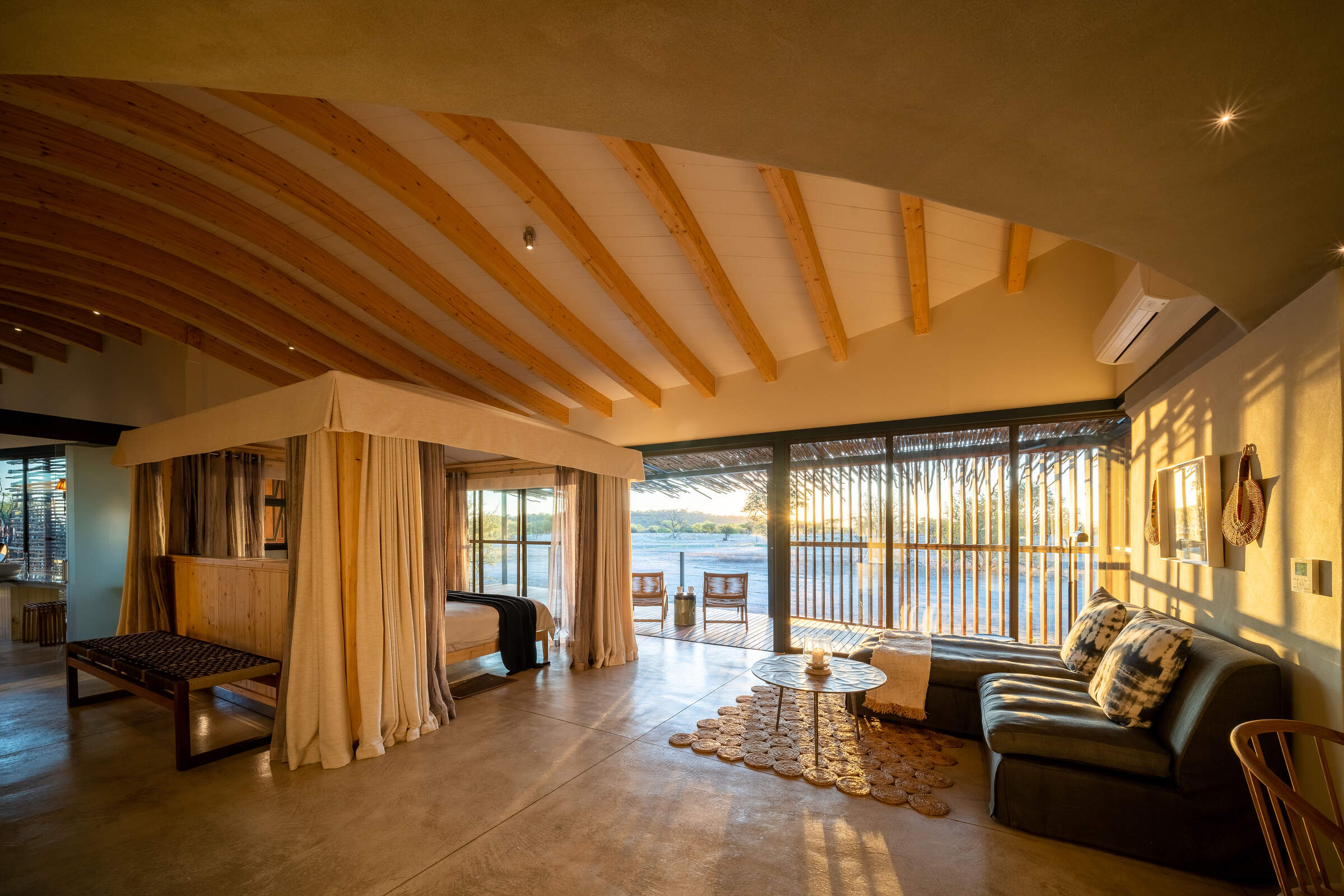
Andersson's at Ongava
With game drives on both its private reserve and in Etosha, Andersson's at Ongava also offers access to the Ongava Research Centre.
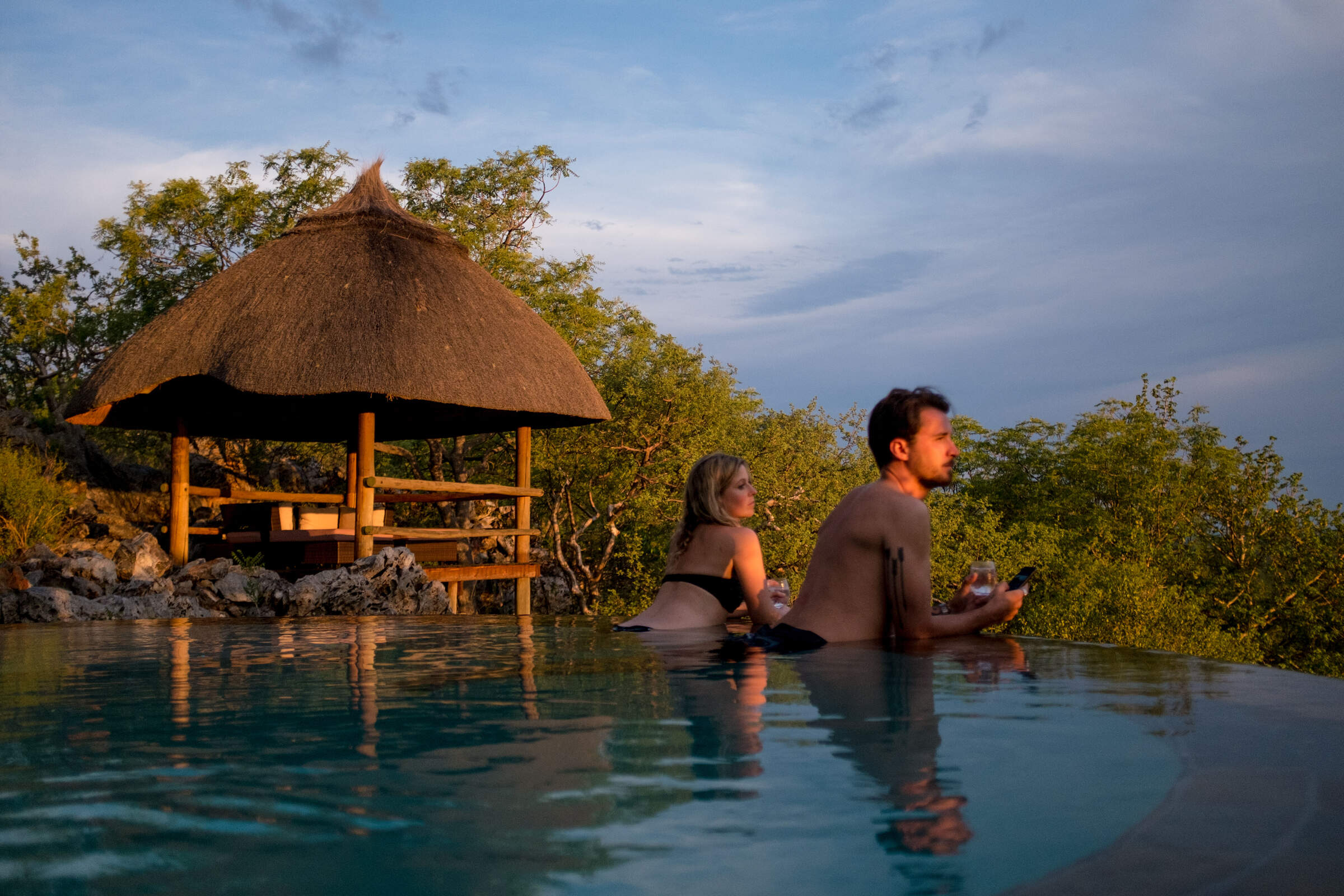
Little Ongava
The beautifully located and luxurious Little Ongava is a stunning place to stay in order to explore Etosha National Park and the private Ongava Reserve.
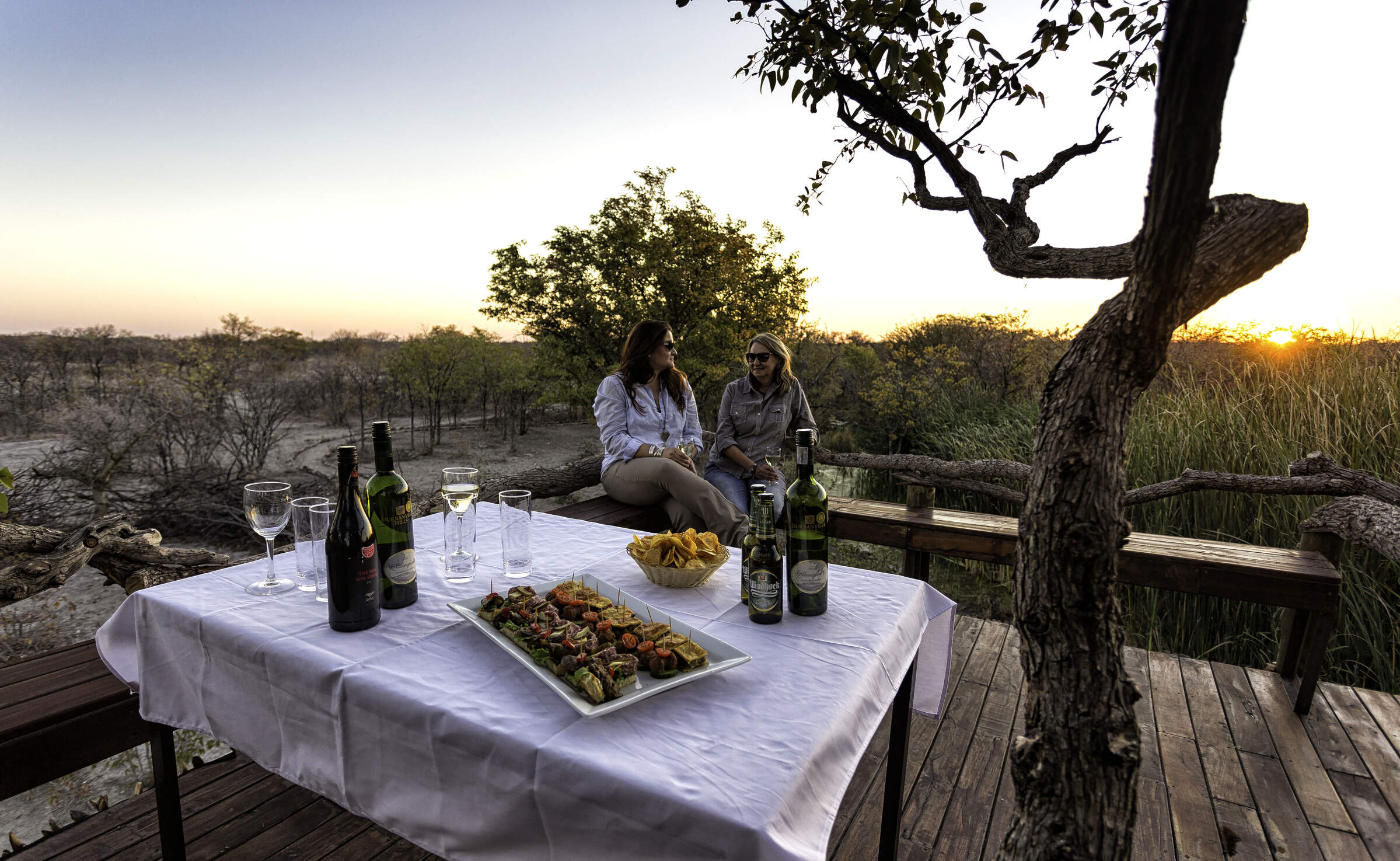
Taleni Etosha Village
Only 4km from Etosha's southern entrance, Taleni Etosha Village is an affordable base from which to explore the park.
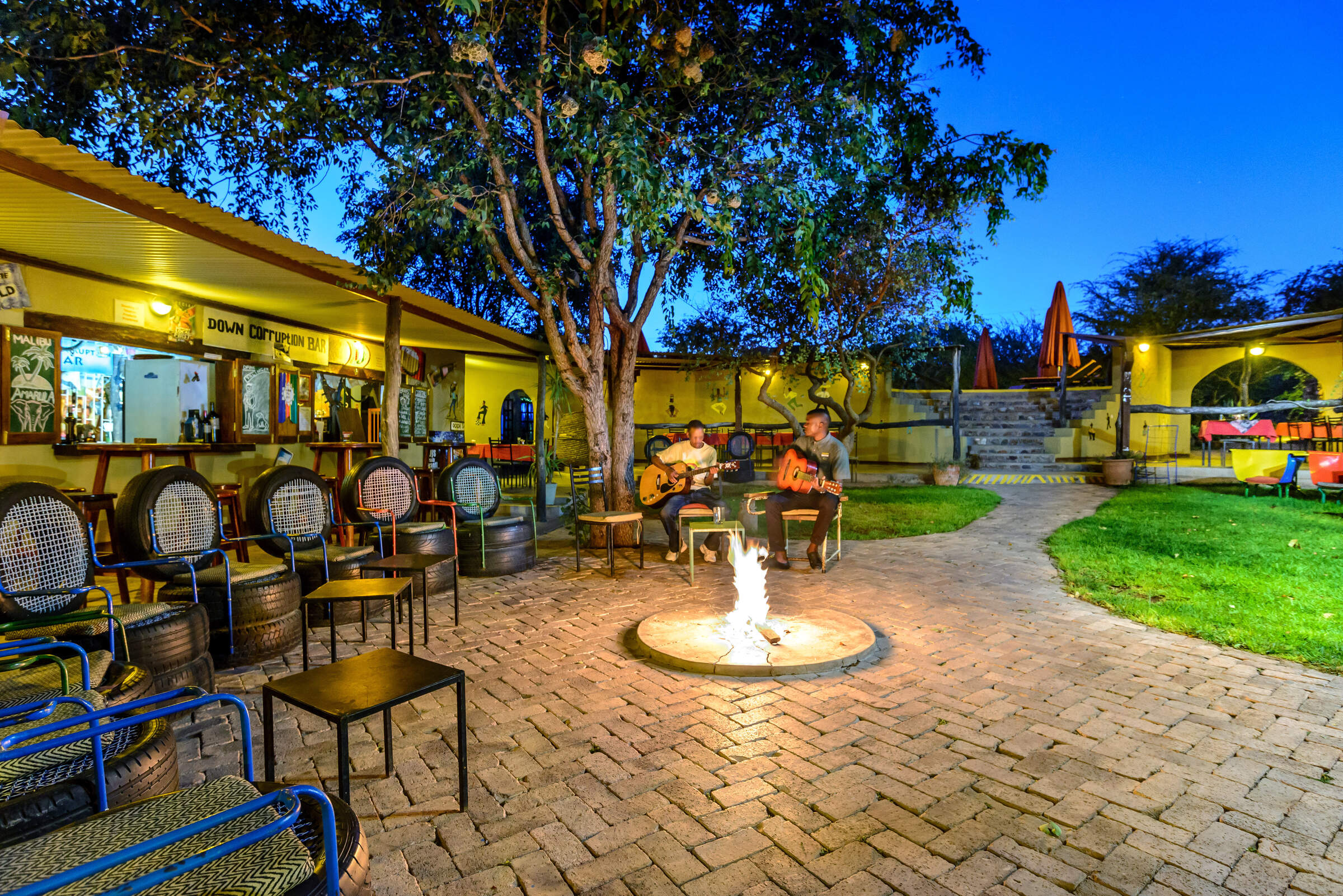
Etosha Safari Camp
Funky, low-key and very original, Etosha Safari Camp is well placed for visiting Etosha National Park on a self-drive or guided safari.
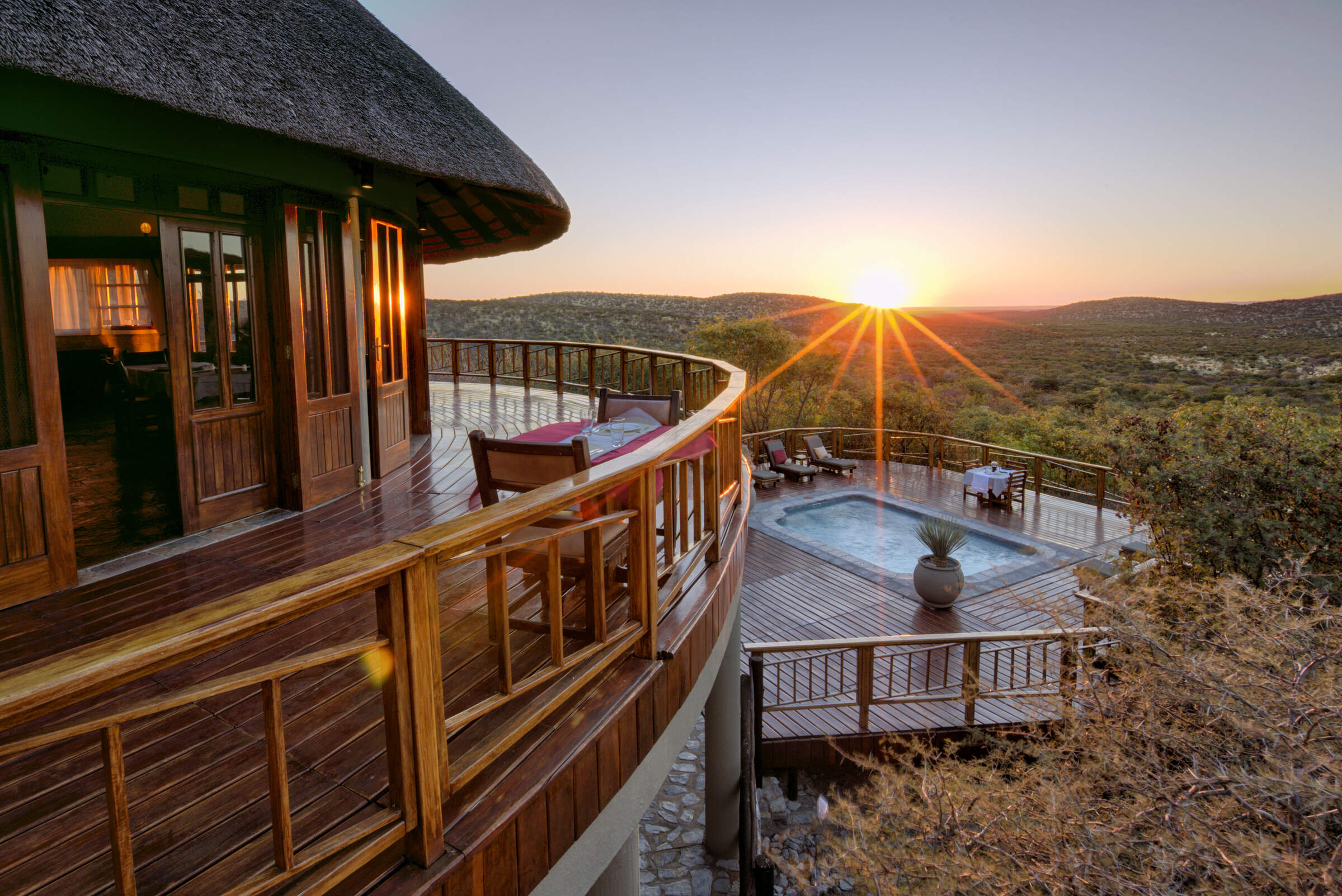
Mountain Lodge
In the heart of the private Etosha Heights Reserve, the family-friendly Mountain Lodge offers game drives and bush walks within an exclusive environment.
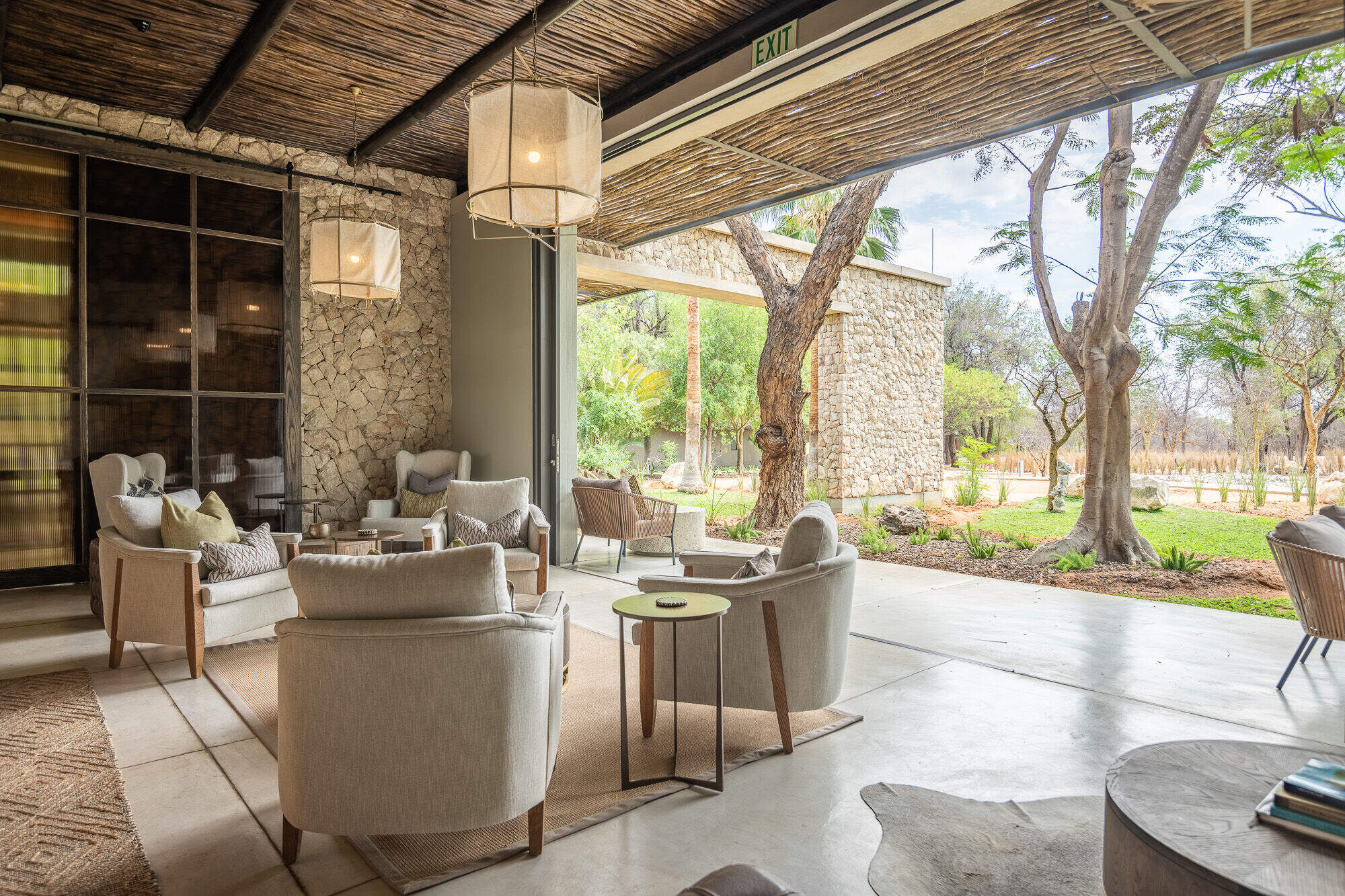
Mokuti Etosha Lodge
With 106 rooms, child-friendly Mokuti Etosha Lodge is more like a hotel than a lodge. Facilities to include a gym, spa, tennis courts and even a snake park.
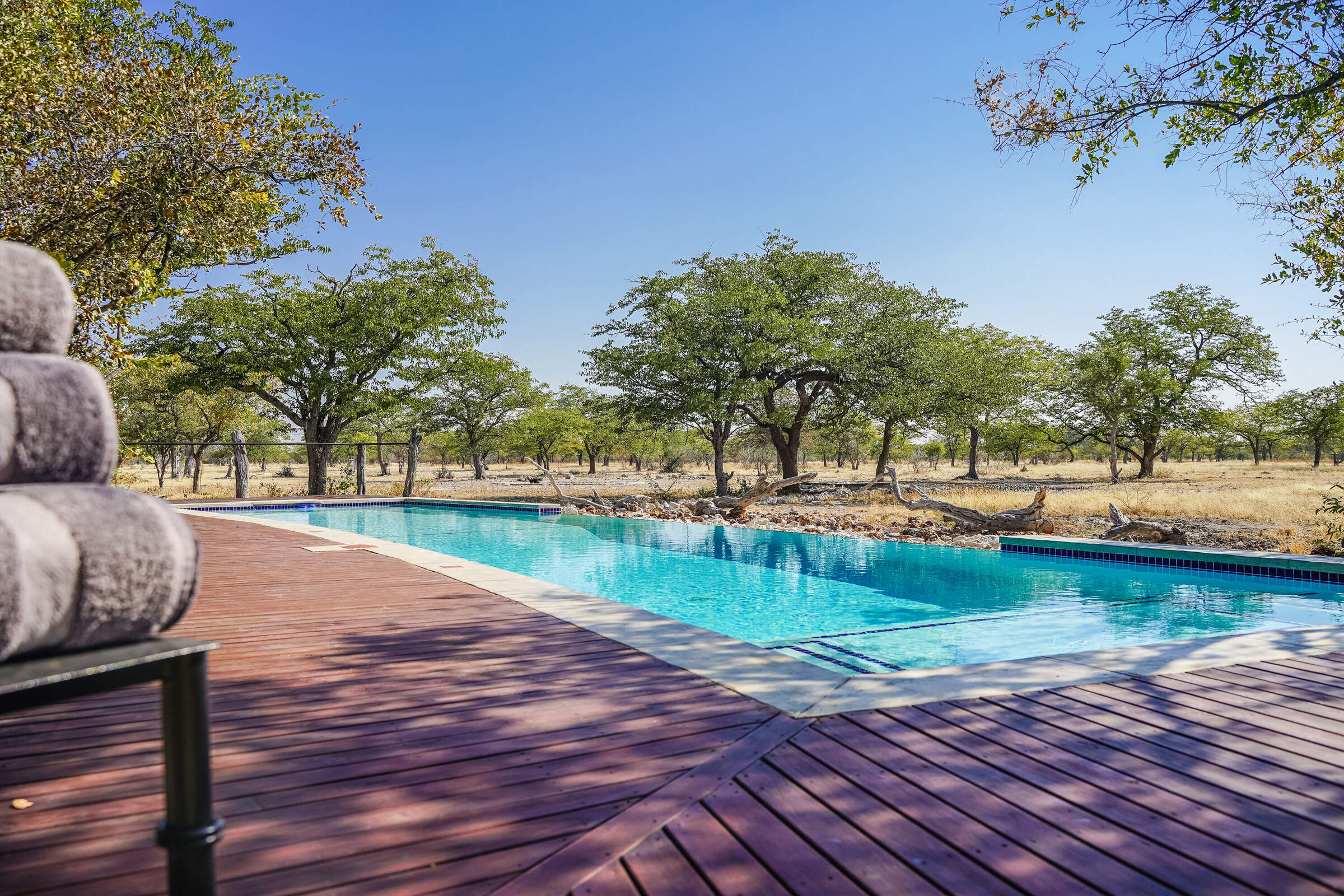
Etosha Oberland Lodge
A short drive from Etosha National Park's southern entrance, Etosha Oberland Lodge is a very comfortable base from which to explore the park, with excellent food.
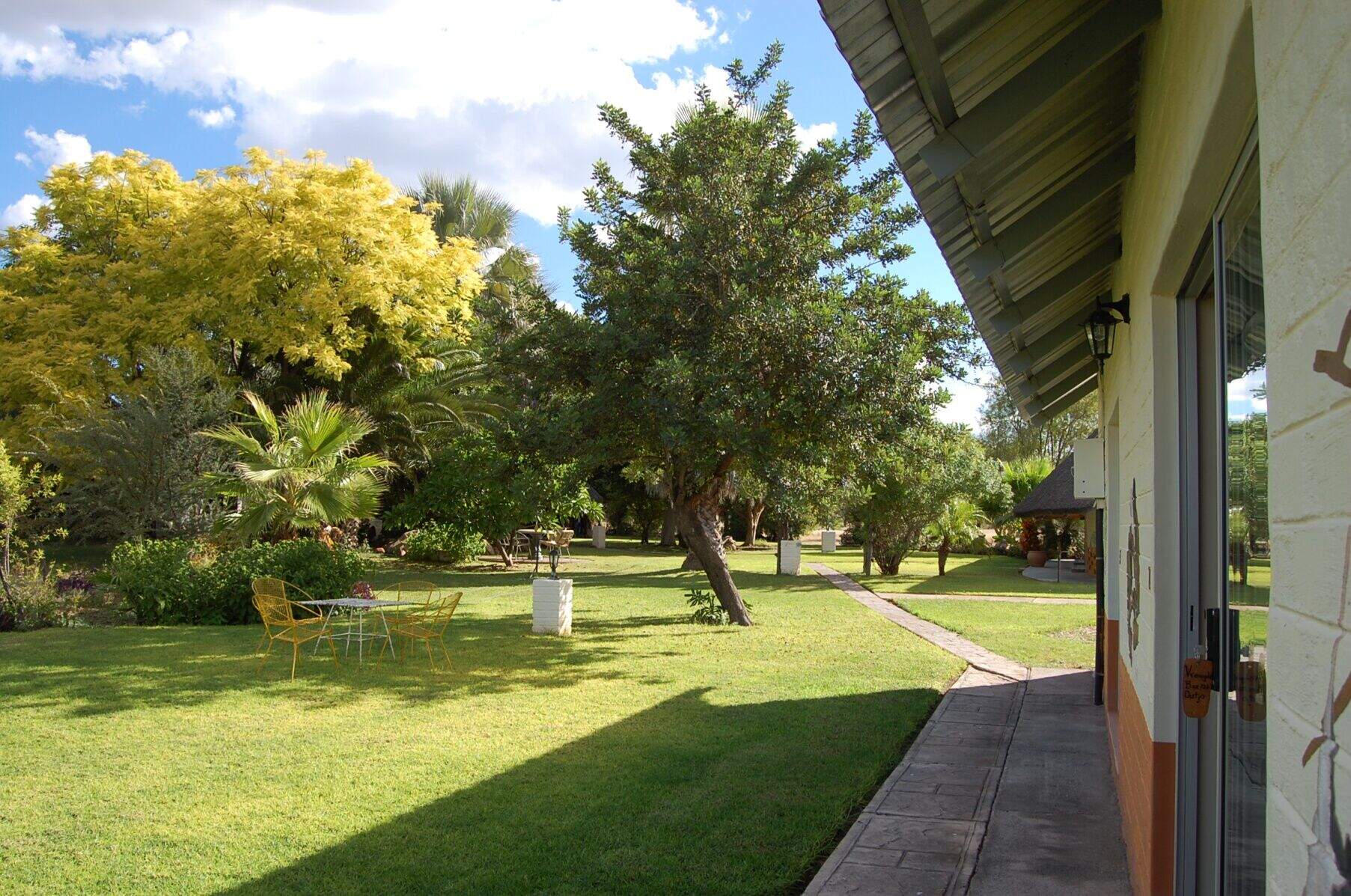
Vreugde Guest Farm
Vreugde Guest Farm is a delightful owner-run and working sheep farm where you can expect a warm welcome and charming hospitality.
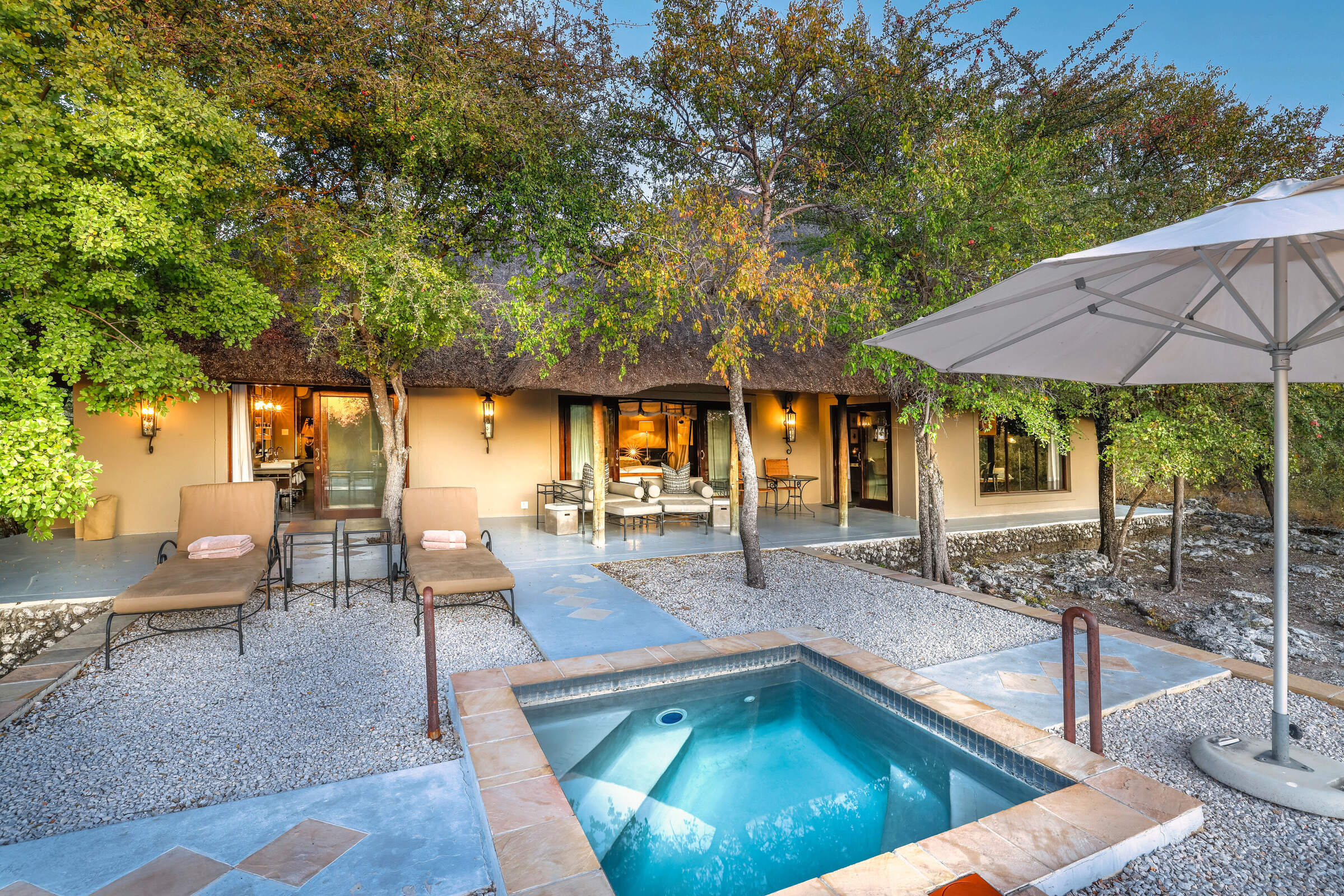
Villa Mushara
Offering luxury on a peaceful private reserve close to Etosha, Villa Mushara is a great choice for honeymooners & those wishing to indulge themselves.
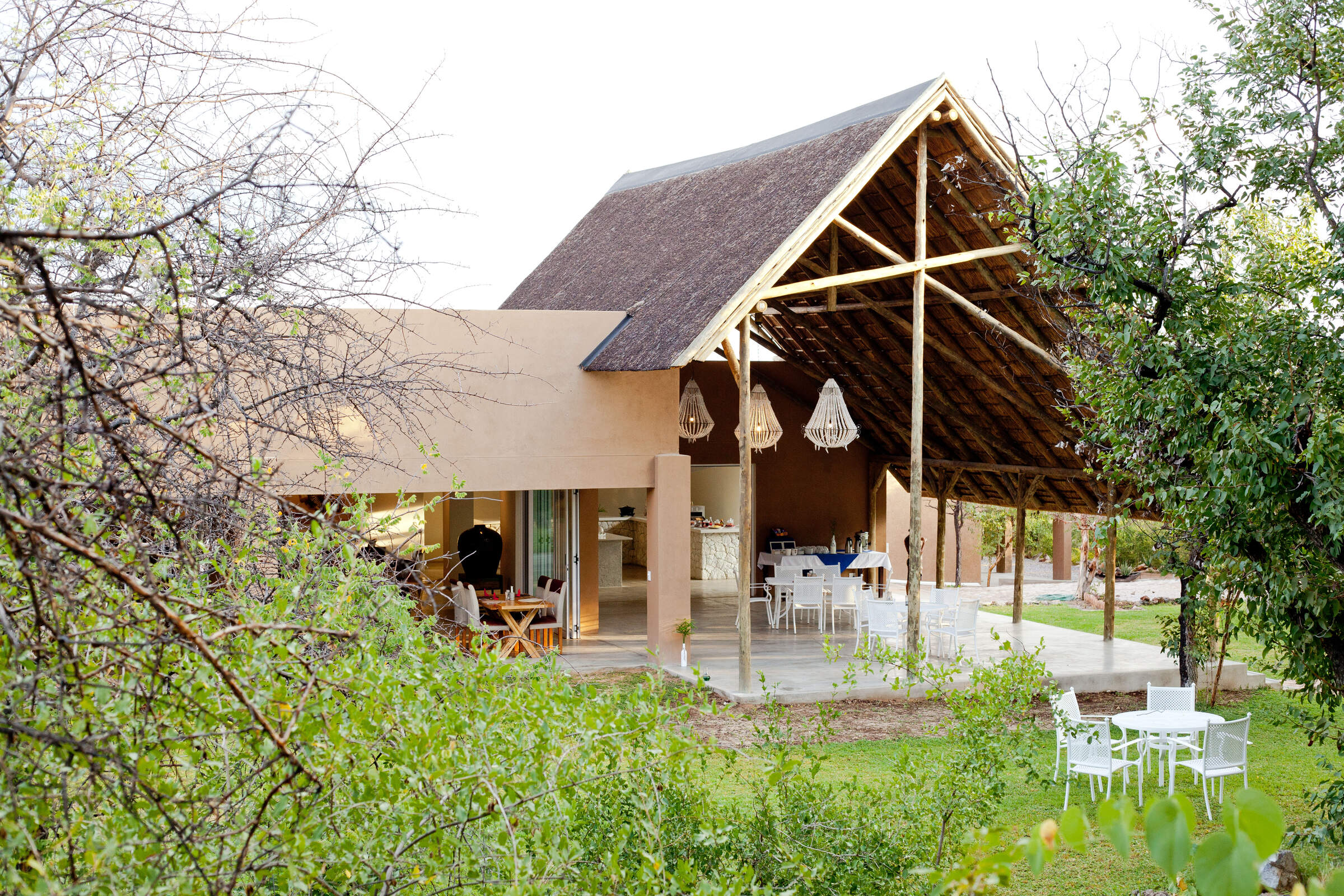
Toshari Lodge
Smart and professionally run, the hotel-style Toshari Lodge is well-placed for self-driving in Etosha National Park.
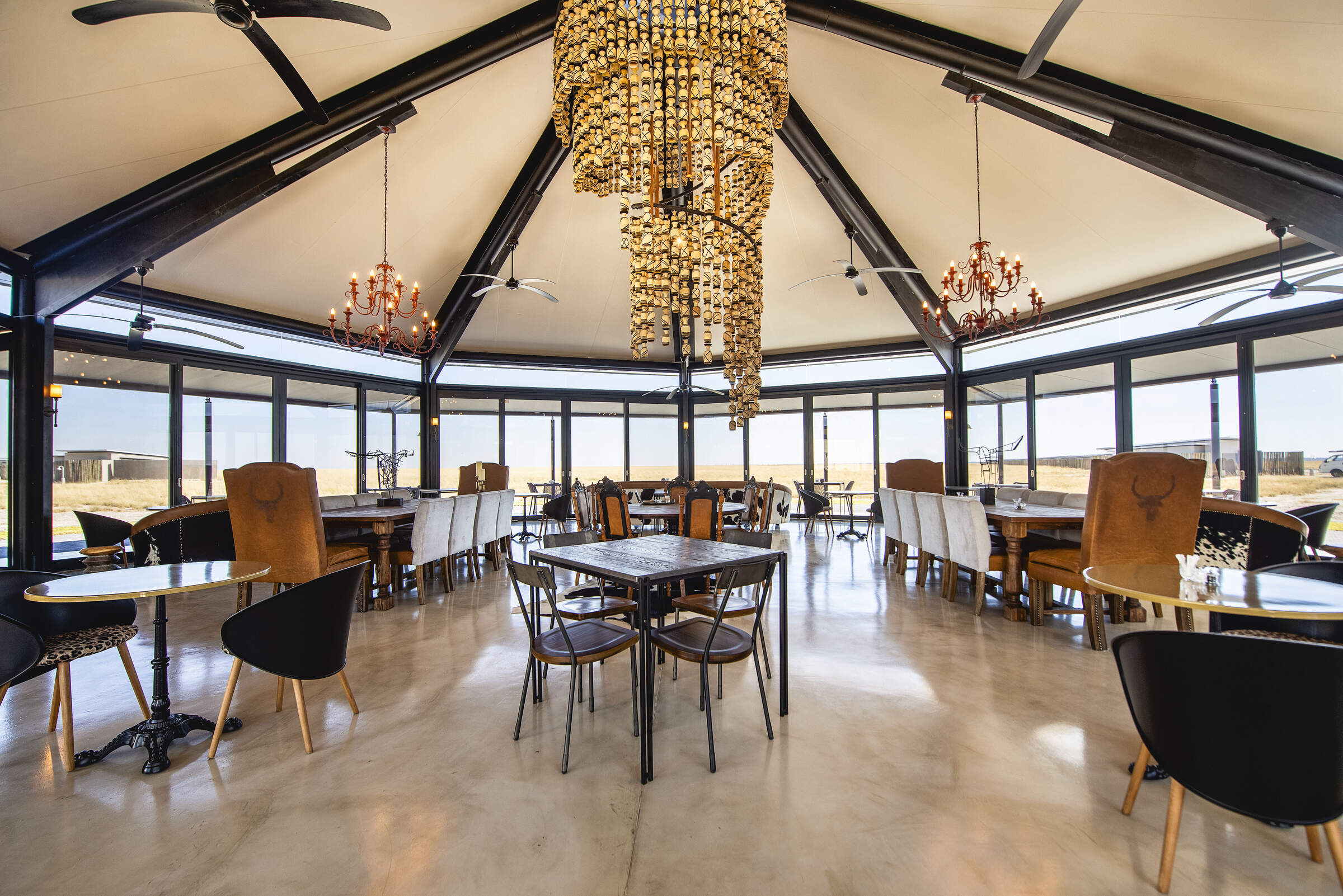
Etosha King Nehale
A short drive from the national park's northern entrance, Etosha King Nehale Lodge is an interesting and comfortable base from which to explore the park.
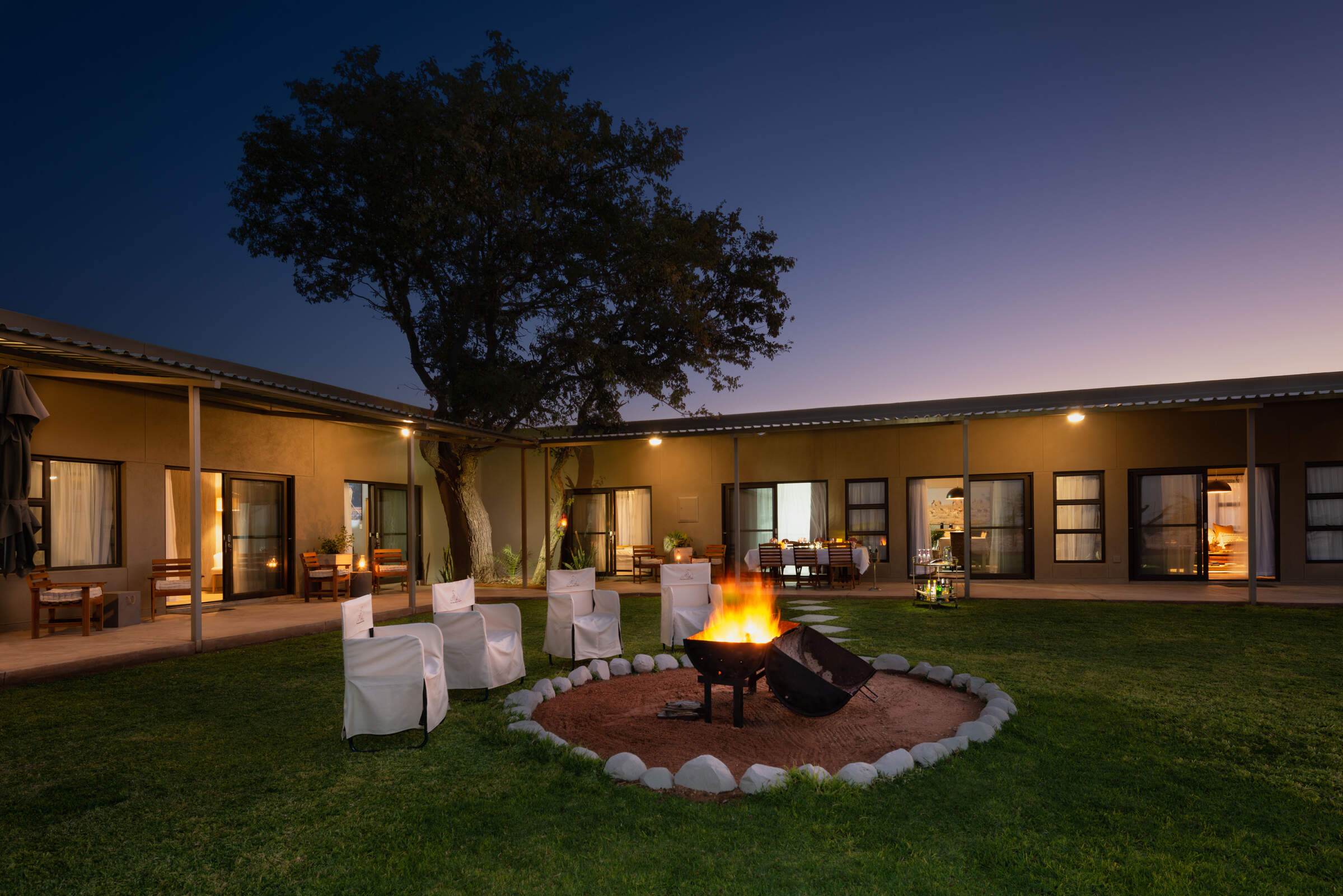
Safari House
The private Safari House on the Etosha Heights reserve is a great option families or friends travelling together.
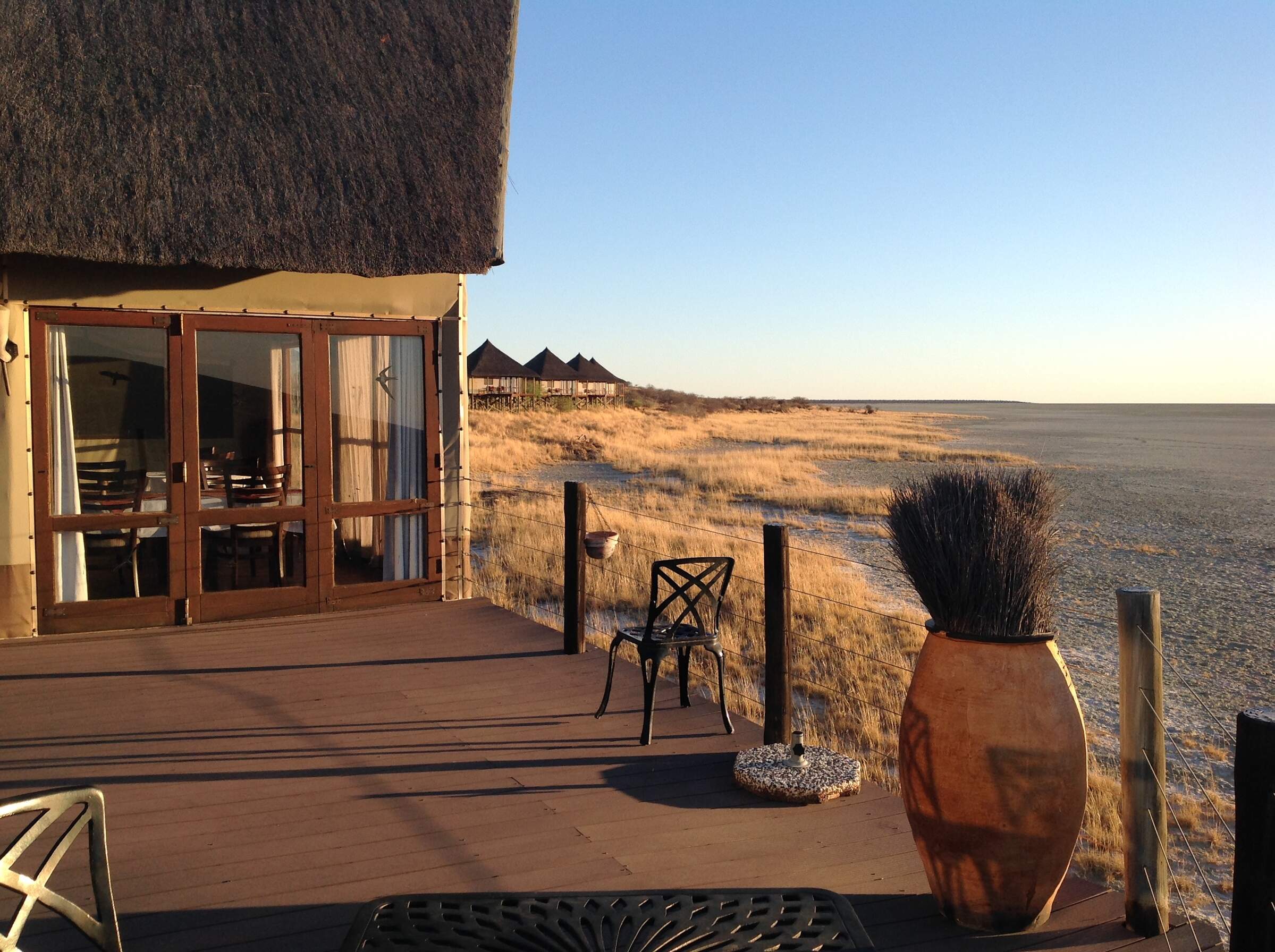
Onkoshi Camp
Onkoshi Camp is owned and run by Namibia Wildlife Resorts. Built on elevated wooden platforms it overlooks Etosha Pan.
When to go to Etosha National Park
Our month by month guide: What it's like to visit Namutoni Camp in Etosha National Park
Jan
Feb
Mar
Apr
May
Jun
Jul
Aug
Sep
Oct
Nov
Dec
Etosha National Park in January
January marks the start of Etosha's main rainy season. The Etosha Pan, usually a vast expanse of white clay, may partially fill with water in good rainy season, attracting flamingos and other migratory birds. The landscape transforms into a lush green oasis, providing ample food for wildlife. Many animals give birth during this time, offering chances to see newborns.
While game viewing can be challenging due to dispersed wildlife and thick vegetation, birdwatching is excellent. Migratory species arrive and birds display breeding plumage. The Okaukuejo and Halali waterholes remain active, though less crowded than in dry months. Visitors should be prepared for occasional thunderstorms and potentially muddy roads, especially around Fischer's Pan.
The vibrant greenery and the presence of young animals make this a fantastic time for photography.
- Variable weather: hot, dry or humid with rain
- Occasional localised thunderstorms in Etosha
- Many animals with young; spectacular birdlife
- Wildlife dispersed, harder to see in Etosha
- Fewer tourists; low rates at most lodges
Our view
This is not a great time to visit
Weather in January
Etosha National Park in February
February is typically Etosha's wettest month. The Etosha Pan may be partially filled, creating a spectacular sight and attracting numerous waterbirds, including flamingos. The landscape is vibrantly green, with many animals raising their young.
While game viewing can be more challenging due to the abundance of water and vegetation, patient observers can spot a variety of wildlife, and share their sightings with fewer other visitors. Birdwatching is excellent, with many species in breeding plumage. The Fairy Tale Forest near Okaukuejo is particularly lush during this time.
Visitors should be prepared for occasional thunderstorms and potentially challenging road conditions, especially in the eastern part of the park. The lush environment and the presence of young animals provide a unique opportunity to witness the park's life cycle.
- Variable weather with occasional thunderstorms
- Bush feels alive; birdlife at its peak in Etosha
- Wildlife in Etosha dispersed, harder to spot
- A variety of newborn and young wildlife to see
- Few tourists; lowest rates for accommodations
Our view
This is not a great time to visit
Weather in February
Etosha National Park in March
As Etosha's main rains taper off, March offers a mix of wet and dry days. The landscape remains green and alive, with insects and smaller animals more easily seen, and many birds and animals are finishing raising their young.
The Etosha Pan may still hold some water, attracting flamingos and other waterbirds. Game viewing improves as the month progresses and animals start to herd together at permanent water sources. The Okaukuejo, Halali, and Namutoni waterholes become increasingly active.
Birdwatching remains excellent, with many migrant species still around. The Dolomite Camp area in the west offers good chances to spot rarer antelope species like black-faced impala.
The transition from wet to dry conditions provides a fascinating glimpse into the park's seasonal changes.
- Weather variable; thunderstorms less frequent
- Animals well-fed after months of abundance
- Wildlife in Etosha still dispersed, harder to see
- Migrant birds prepare to leave the park
- Few visitors; rates often low at Etosha lodges
Our view
A good time to visit, with pros & cons
Weather in March
Etosha National Park in April
April typically sees dry weather dominating in Etosha, with decreasing chances of rain. The landscape remains relatively green, and animals are in excellent condition with shiny coats. Increasing numbers of elephants seen as the herds begin to use the permanent water sources. The Okaukuejo waterhole becomes particularly active, especially in the evenings.
Photographers benefit from clear air and lush, green backdrop. Night drives from camps like Halali offer chances to see nocturnal animals. Birdwatching remains good, though some migratory species begin to depart, and the Fischer's Pan area can still be productive for waterbirds if there's residual water from the rainy season.
The shift towards drier conditions improves the chances of wildlife sightings.
- Becoming drier and cooler, especially at night
- Few visitors except around Easter; low rates
- Wildlife in Etosha still relatively spread out
- Migrant birds have largely left the park
- Fresh air and often green landscapes in Etosha
Our view
A good time to visit, with pros & cons
Weather in April
Etosha National Park in May
May marks the transition to Etosha's dry season. The landscape starts to dry out, but may still retain some greenery. Wildlife increasingly gathers around permanent water sources, making game viewing more predictable. The Okaukuejo, Halali, and Namutoni waterholes become excellent spots for animal observation – especially when floodlit after dark. Night drives offer opportunities to see nocturnal species like leopards and owls.
The Etosha Pan is usually dry, creating a stark, shimmering backdrop for photography. Birdwatching remains good, with 340 different species recorded in the park. The western part of the park, accessible from Dolomite Camp, offers chances to see rarer species like black rhino in a less frequently explored environment. The dry season's onset brings a new rhythm to the park's wildlife dynamics.
- Lovely weather: dry, warm days & cool nights
- Etosha drying out; landscapes still partly green
- Fantastic air clarity; ideal for photography
- Visitor numbers low; lodge rates still low
- Wildlife starting to gather at Etosha waterholes
Our view
A very good time to visit
Weather in May
Etosha National Park in June
June brings cooler temperatures with clear skies to Etosha. The landscape is drying out, encouraging animals like elephants, rhino and giraffe to waterholes. This makes for excellent game viewing, especially at popular spots like Okaukuejo and Halali. Night drives on private Etosha reserves, like Ongava, are particularly productive.
The dry Etosha Pan creates mirages and a unique backdrop for photography, perhaps a lone ostrich crossing the stark salt crust. Birdwatching remains rewarding, with bright colours standing out in drier vegetation. The Namutoni area, with its fort, provides a mix of wildlife viewing and historical interest.
Cooler temperatures making walking safaris enjoyable in Etosha’s adjacent wildlife reserves, like Etosha Heights.
- Clear days, cold nights in Etosha National Park
- Great air quality; perfect for photographers
- Moderate lodge rates; shoulder season begins
- Wildlife gravitates to Etosha's waterholes
- Some greenery remains in parts of the park
Our view
A very good time to visit
Weather in June
Etosha National Park in July
July is prime time for wildlife viewing in Etosha as animals, in particular predators, are more active later in cool mornings and earlier in the afternoons. The dry landscape concentrates animals around waterholes, making for predictable and spectacular sightings. The Okaukuejo waterhole is particularly active, especially at night when black rhinos often visit and jostle for position with elephants.
The stark white Etosha Pan creates a unique backdrop for photography, with heat mirages shimmering on the horizon.
The dry season's peak offers unparalleled wildlife viewing opportunities. Game drives along the southern edge of the pan offer excellent opportunities to see large herds of zebra, wildebeest, and antelope. Birdwatching is rewarding around waterholes, with species like eagles and vultures frequently sighted.
- Dry days, crisp nights; excellent for stargazing
- European holidays begin; more families visit
- Peak season; high rates, lodges often full
- Fantastic wildlife watching
- Animals concentrate around Etosha waterholes
Our view
A very good time to visit
Weather in July
Etosha National Park in August
August is the height of the dry season in Etosha, offering excellent wildlife viewing opportunities. Animals concentrate around waterholes, with a variety of predators and prey often seen at any one time. Night viewing at the more secluded yet floodlit waterhole at Halali is often rewarded with sightings of shyer leopard and porcupine.
The dry season's intensity brings wildlife into sharp focus. The open plains along the edge of the Etosha Pan are good for seeing large herds of zebra and wildebeest, and often cheetah too. Predators often lie in wait for their prey near waterholes offering sightings of hunts to patient game viewers.
Birdwatching remains rewarding, with raptors like bateleur and martial eagles frequently sighted.
- Dry days, cold nights; clear skies in Etosha
- Busy by Namibian standards; family rooms full
- Peak season; high rates, advanced booking needed
- Excellent wildlife viewing in Etosha National Park
- Large herds gather at Etosha's waterholes
Our view
Fantastic: the very best time to visit
Weather in August
Etosha National Park in September
September offers peak wildlife viewing in Etosha. The extreme dry conditions concentrate animals around waterholes, making for spectacular sightings of multiple species. The Okaukuejo waterhole is particularly active, with elephants, rhinos, and lions frequently visiting.
The last months of the dry season showcases the park's wildlife at its most concentrated. The stark landscape of the dry Etosha Pan creates dramatic backdrops for photography. Game drives along the pan's edge offer chances to see large herds of zebra, springbok, and oryx as well as lion prides and cheetah. The western part of the park, accessible from Dolomite Camp, often provides a more exclusive safari experience with good rhino sightings. Night drives on adjacent private reserves like Hobatere offer opportunities to see nocturnal animals such as genets and aardwolves.
Birdwatching is excellent, with species standing out clearly in the sparse vegetation.
- One of the best months for Etosha wildlife viewing
- Warm days, cold nights; temperatures rising
- Colourful birds stand out against a starker backdrop
- Etosha's waterholes teem with diverse wildlife
- High season; book Etosha accommodations early
Our view
Fantastic: the very best time to visit
Weather in September
Etosha National Park in October
October is typically Etosha's hottest and driest month, offering excellent wildlife viewing. The intense heat and dry conditions heighten the drama of wildlife interactions.
Animals concentrate heavily around waterholes, with spectacular sightings common at Okaukuejo, Halali, and other permanent water sources. Patient photographers spending time at waterholes are richly rewarded. Large herds of zebra, wildebeest, and various antelope species can be seen along the pan's southern edge. Predator sightings, including lions and cheetahs, are frequent as they target gathered and weakened prey. Thinning vegetation at Namutoni makes it easier to spot the dimunitive Damara dik dik – Namibia’s smallest antelope.
Birdwatching remains rewarding, with raptors and colourful rollers often spotted.
- Peak wildlife-viewing month in Etosha National Park
- Hot and dry; Etosha feels like a desert
- Air can be hazy with dust in some areas
- Peak time; expect high season rates in Etosha
- Etosha lodges often full, especially early October
Our view
A very good time to visit
Weather in October
Etosha National Park in November
November marks the transition to Etosha's rainy season, bringing change to the landscape and wildlife behaviour. Early rains may green the vegetation, dispersing some wildlife from waterholes. However, game viewing remains good, especially around permanent water sources like Okaukuejo and Halali’s floodlit waterholes.
The first rains can create dramatic scenes as animals celebrate the water's arrival, with plains game often giving birth. Predators often give birth at this time too, to coincide with the time of plenty. Migratory birds begin to return, and birds take to the skies in spectacular aerial shows as they catch more active insects.
Seasonal wildflowers and dramatic, thundery skies add interest to photographic compositions. Summer rains bring reptiles such as tortoises and chameleons out into the open. The onset of rains brings a refreshing change to the park's ecosystem.
- Variable month in Etosha, depending on rains
- If rain comes, explosion of vegetation and life
- Baby animals often born around mid-month
- Shoulder season; mid-range rates offer value
- Showers more likely later in the month in Etosha
Our view
A good time to visit, with pros & cons
Weather in November
Etosha National Park in December
December is often a drier month before January sees the main rainy season begin. The landscape begins to show green from November's rain and the odd rainshower in December. Many animals have young, so there’s the chance to watch frolicking calfs and lambs.
The combination of rainfall and sunshine rejuvenates the park's landscapes and wildlife. While wildlife disperses away from the waterholes with increased water availability, game viewing remains good, especially on the open plains along the southern edge of Etosha Pan. Birdwatching is excellent, with many species in breeding plumage and displaying for mates as well as migrant species arriving.
Visitors should be prepared for occasional thunderstorms and potentially muddy roads, especially in the eastern part of the park.
- Hot, sometimes humid with cooling showers
- Landscapes green where rain has fallen in Etosha
- New life and energy in the park's ecosystem
- Excellent for birdwatchers in Etosha
- Larger animals may be harder to spot
Our view
This is not a great time to visit
Weather in December

Looking for inspiration on where to travel next?
Visit our trip chooser to explore your options and find inspiration for your perfect African adventure
Inspire me